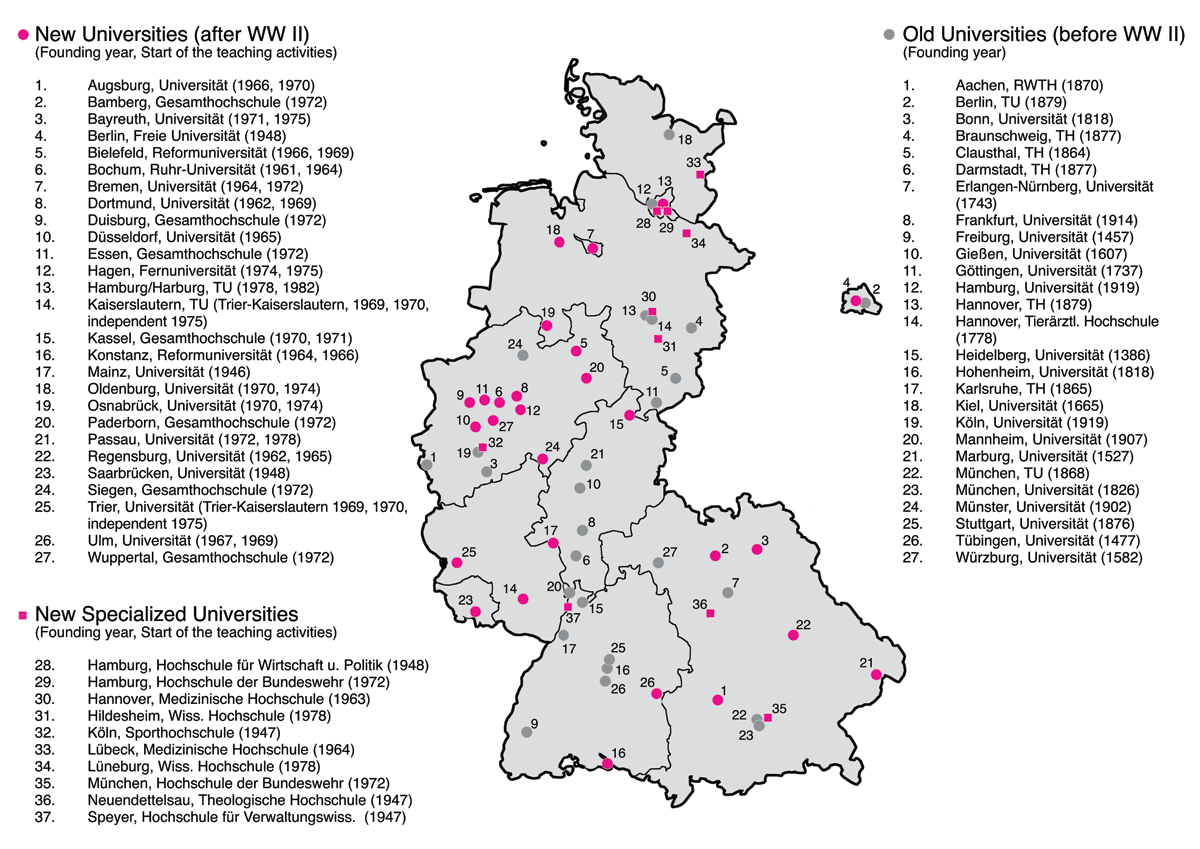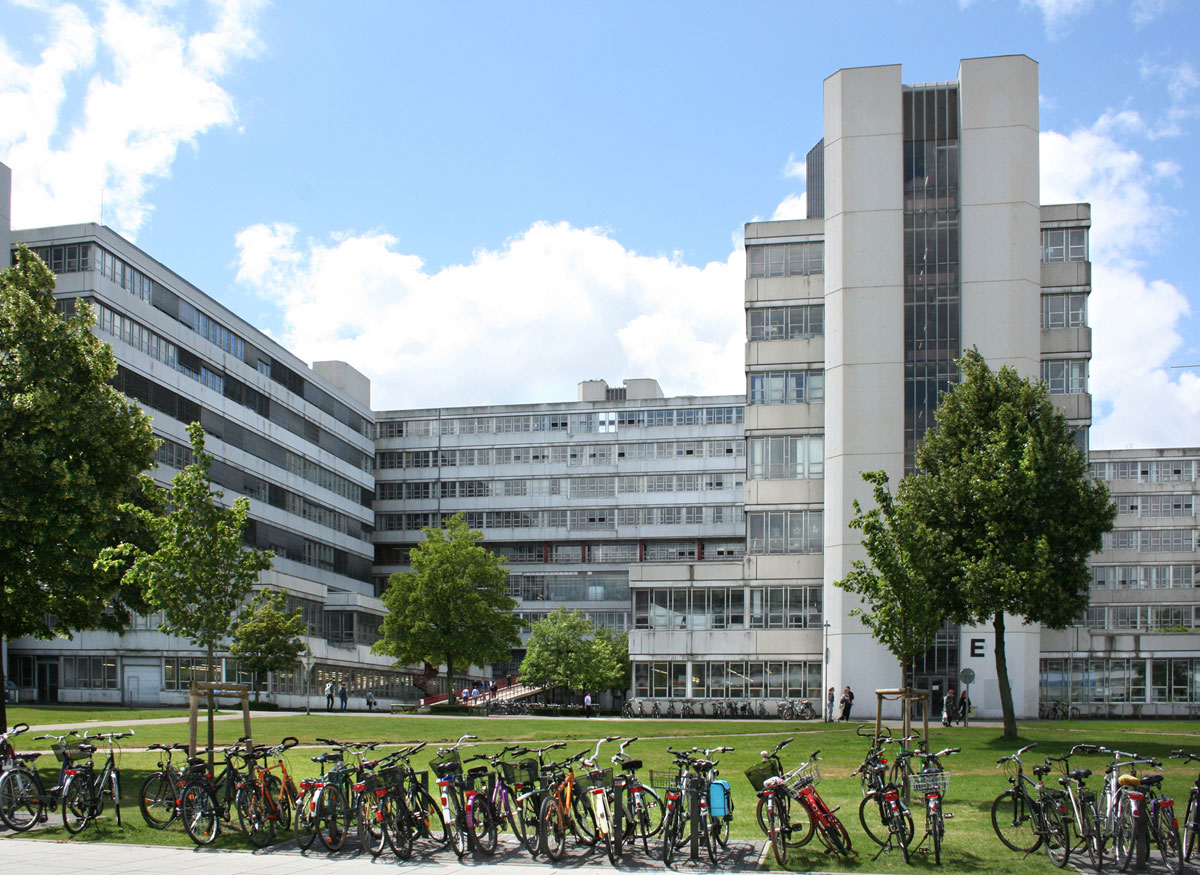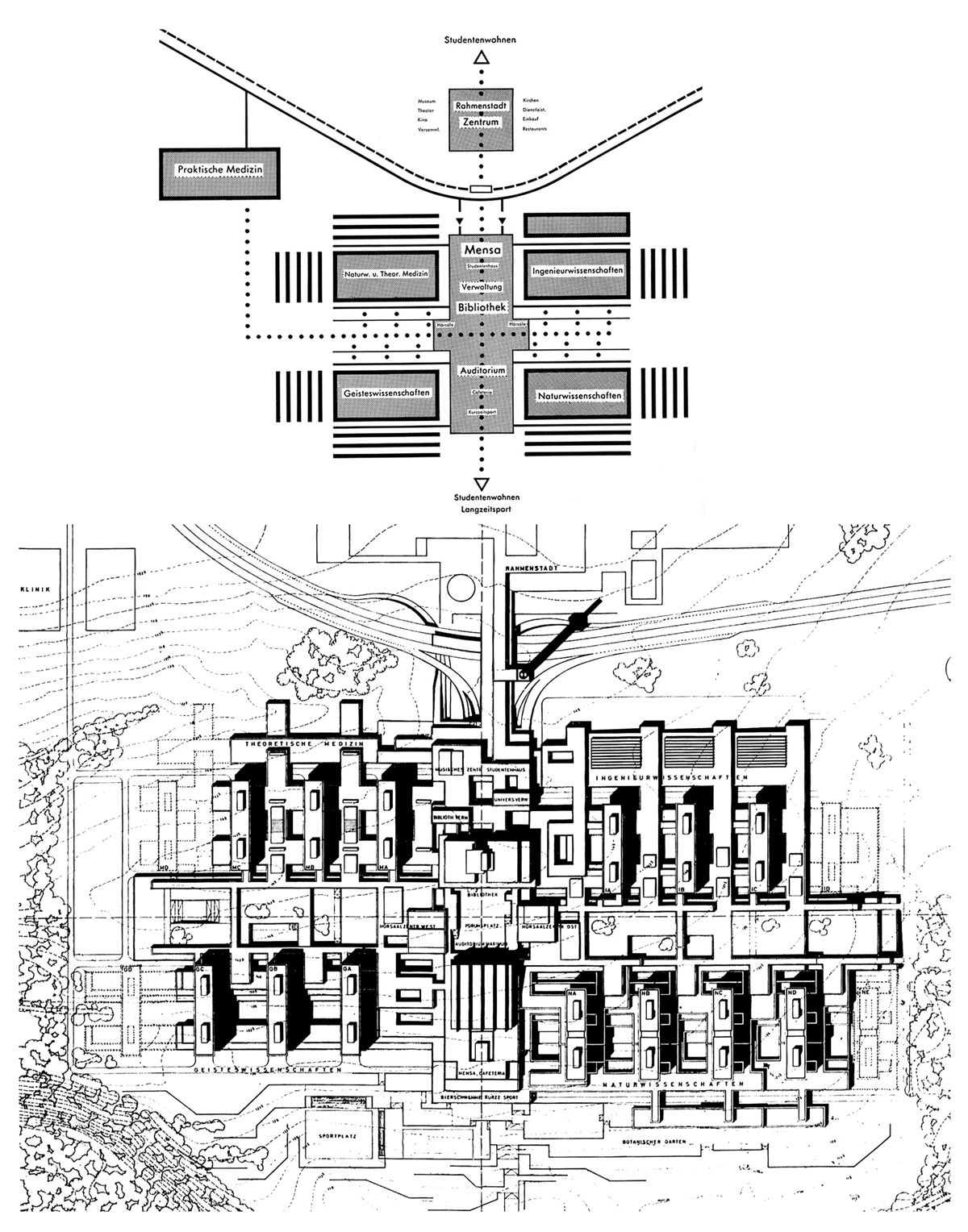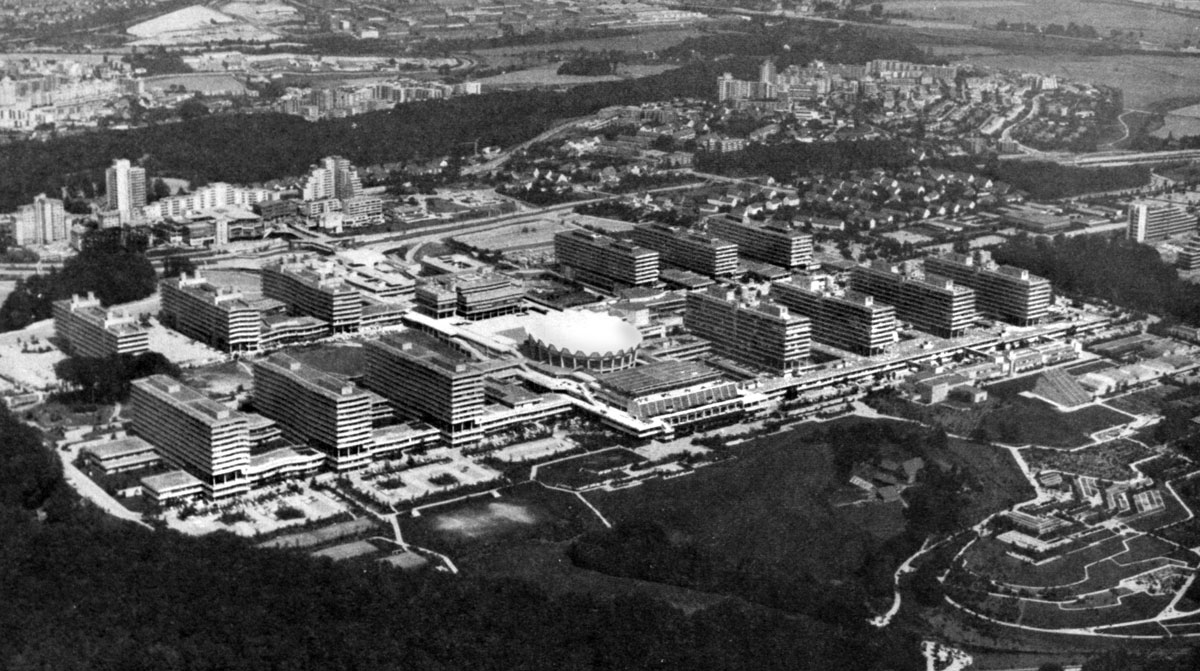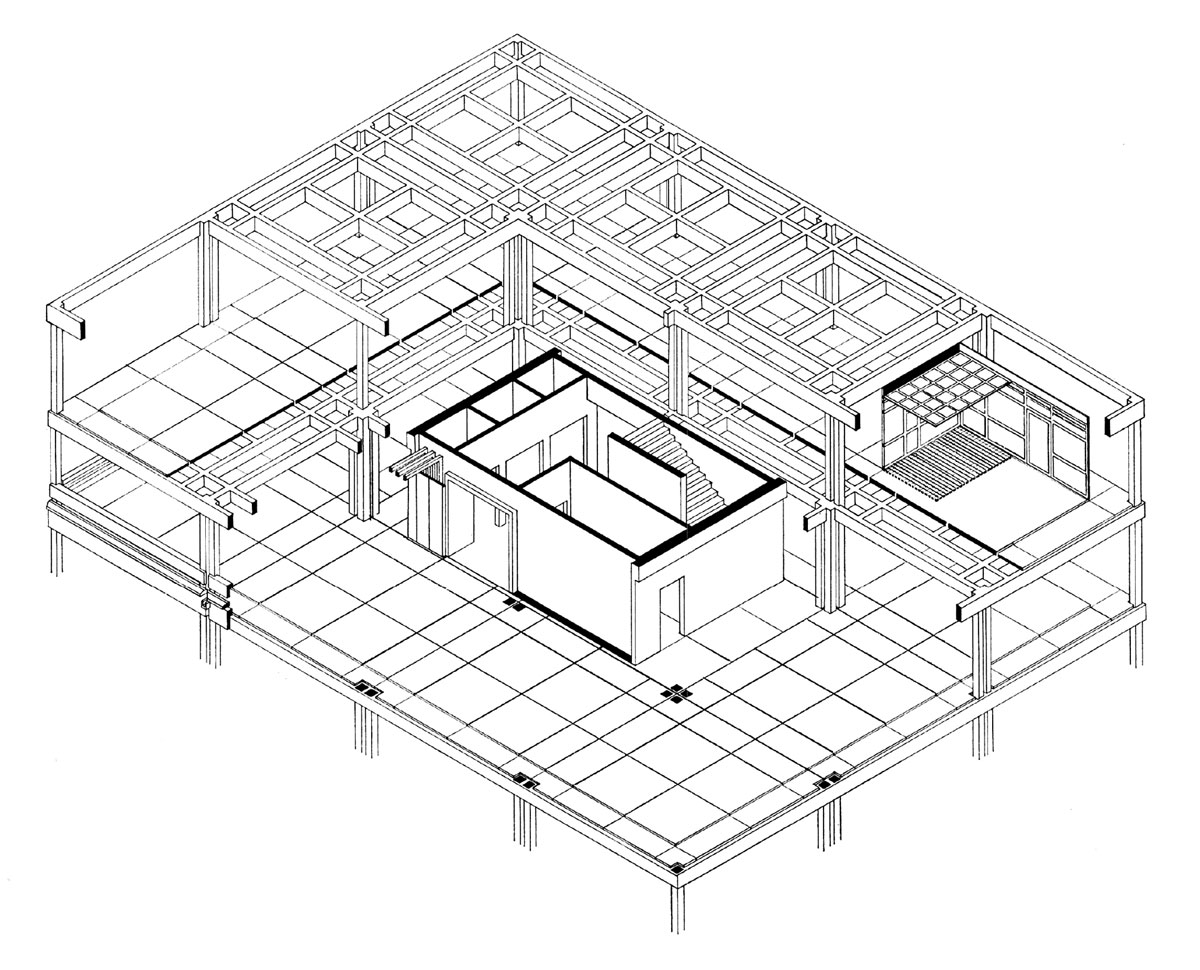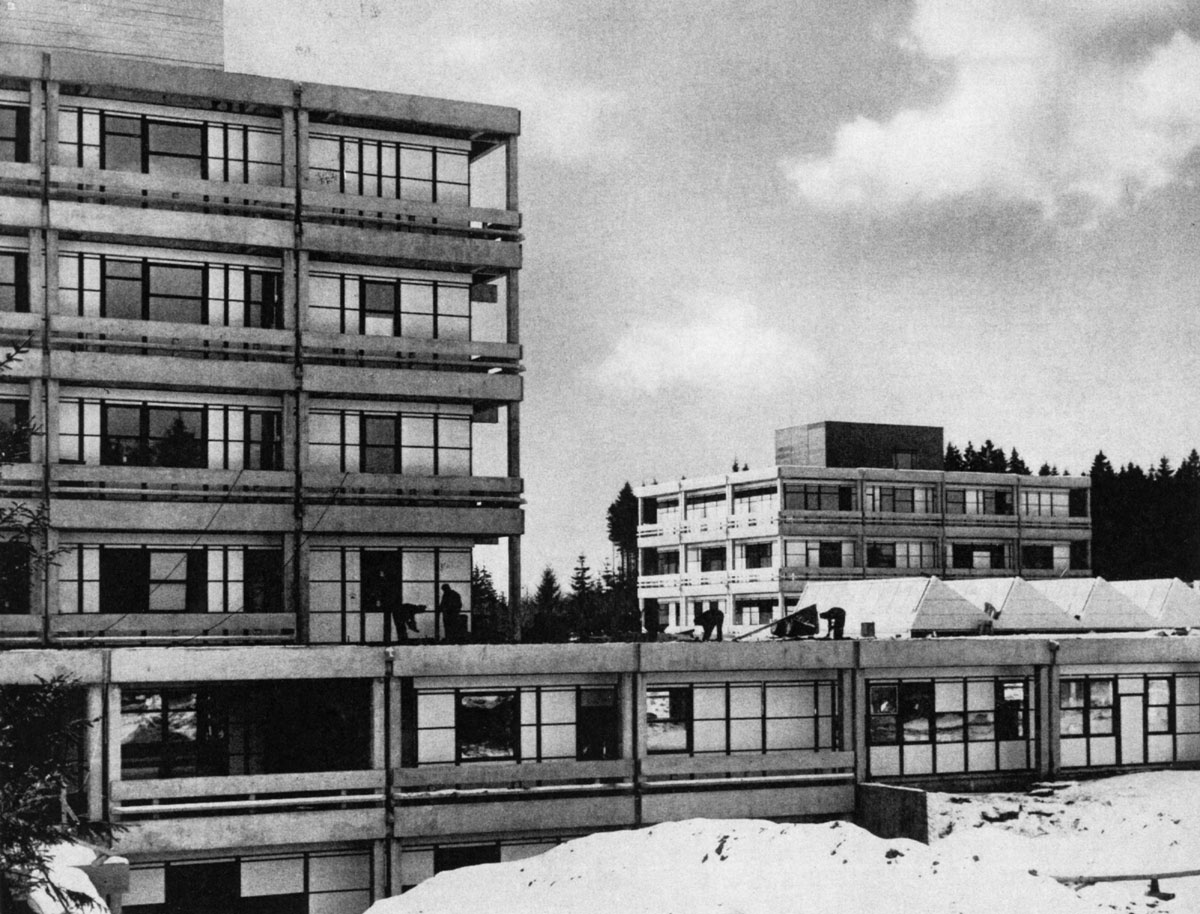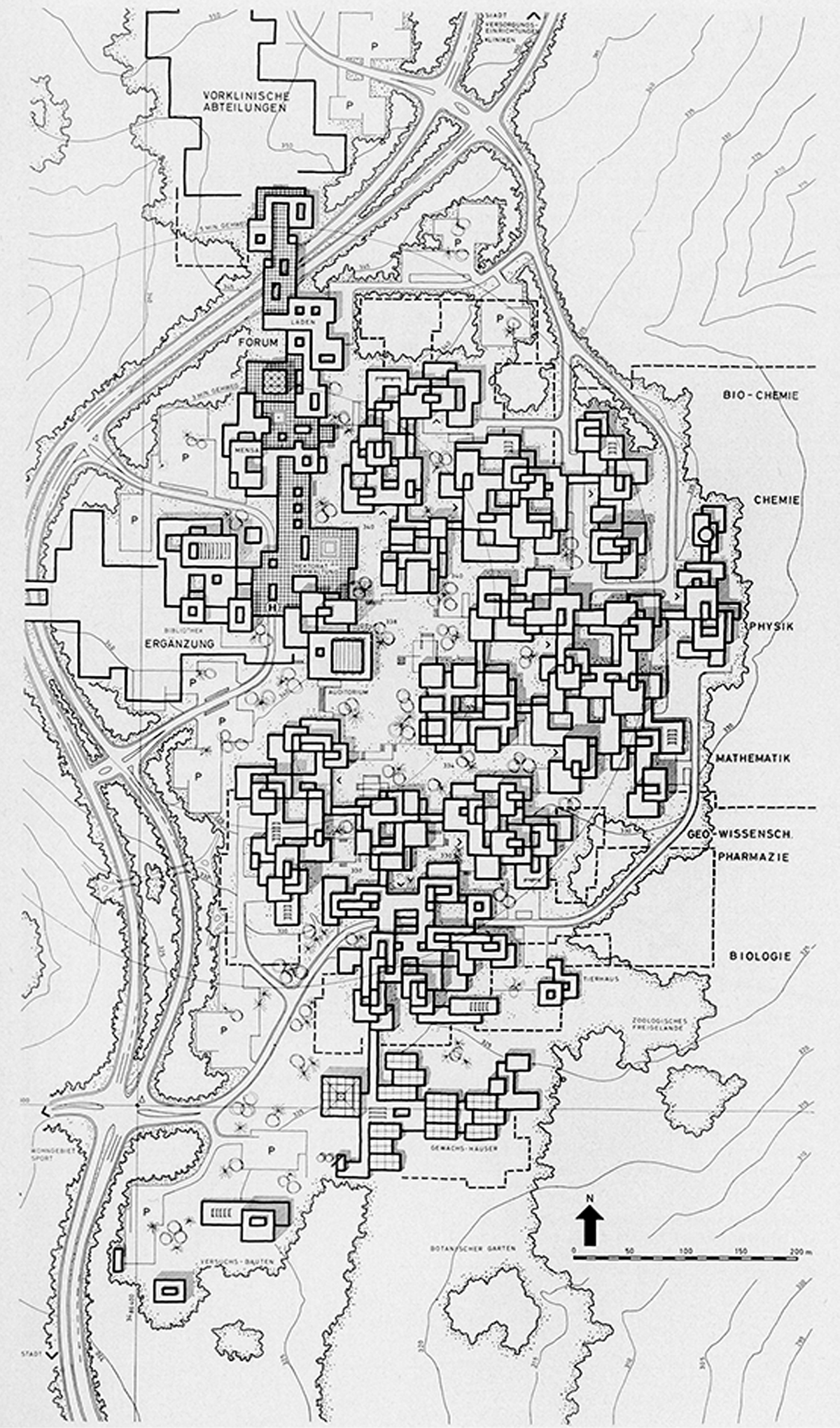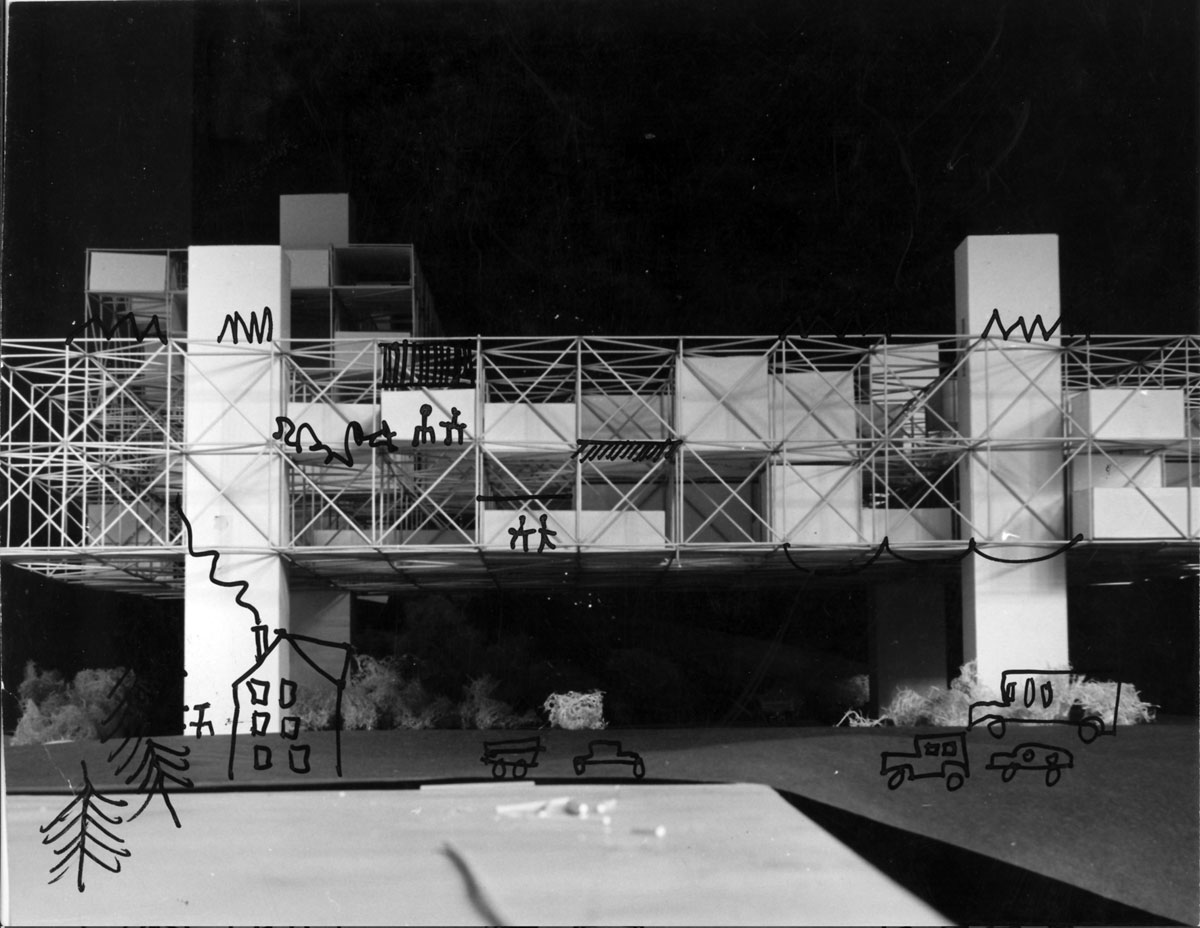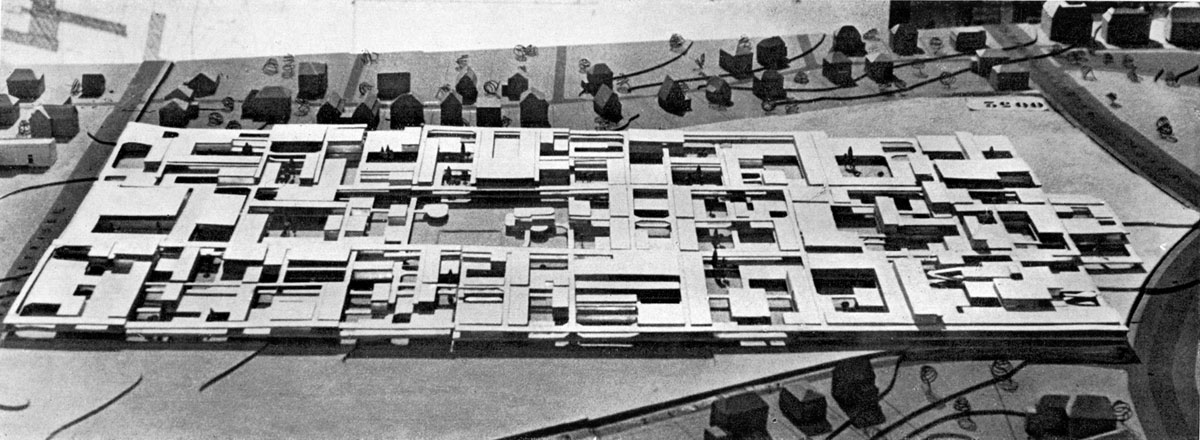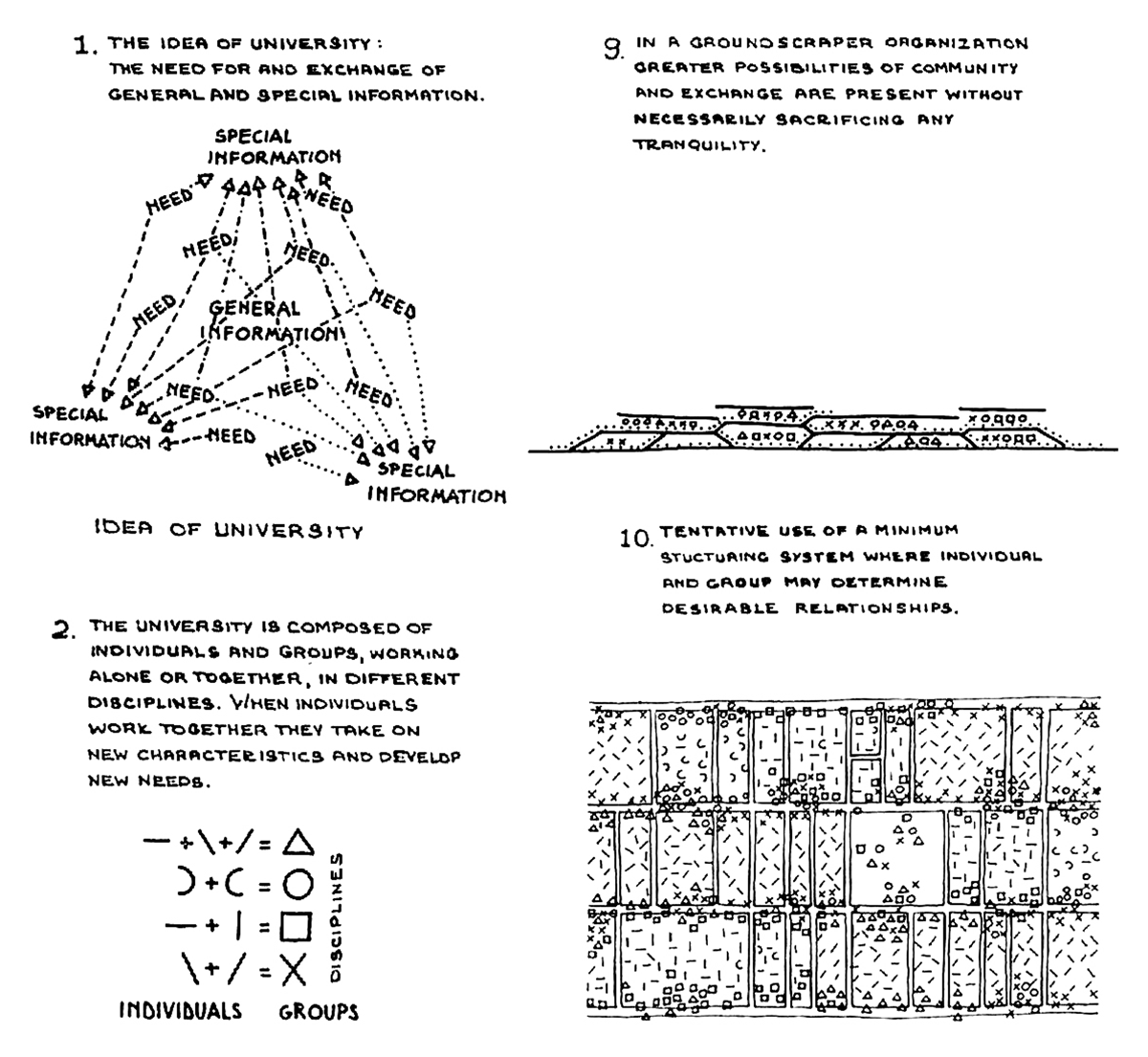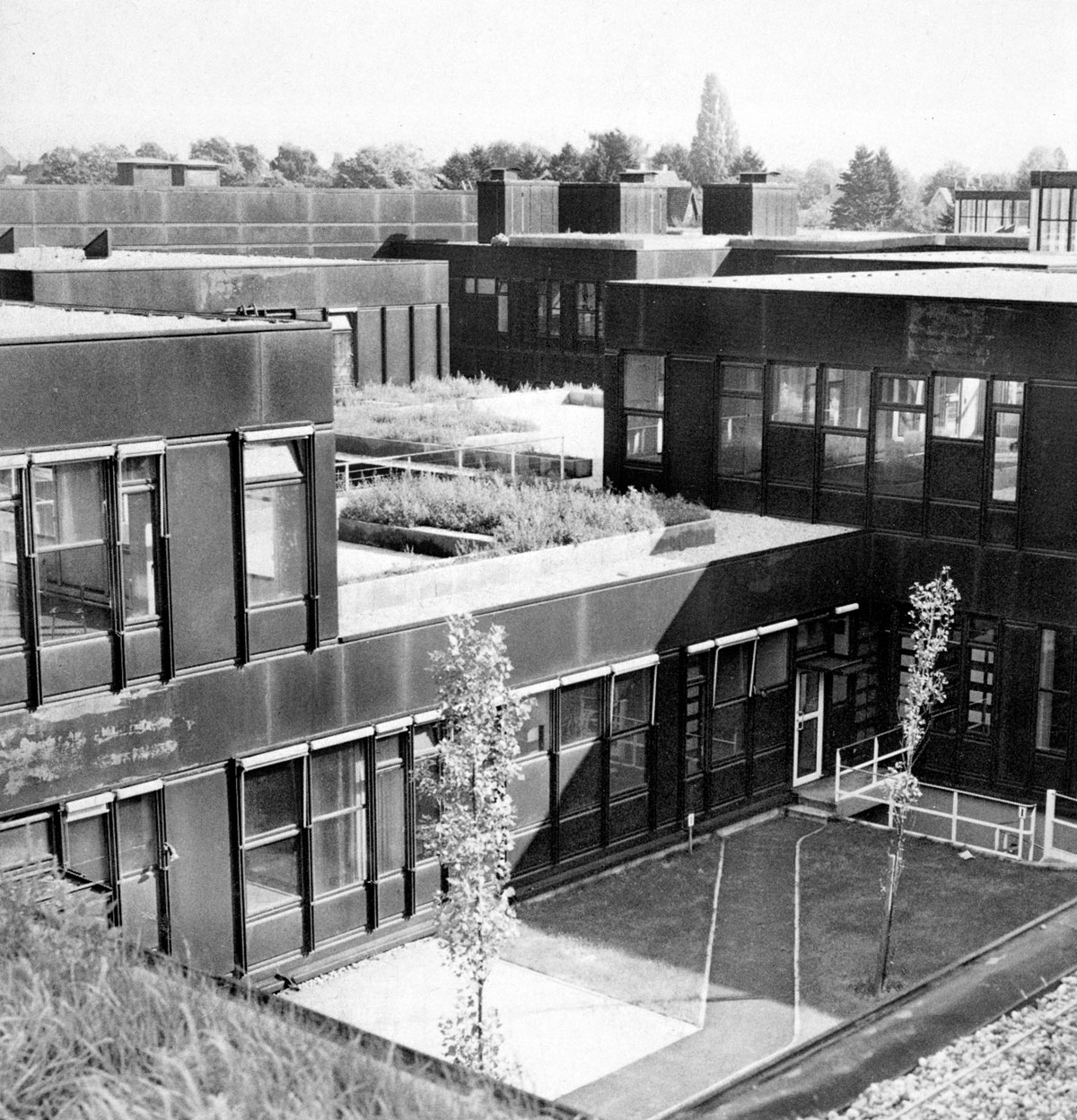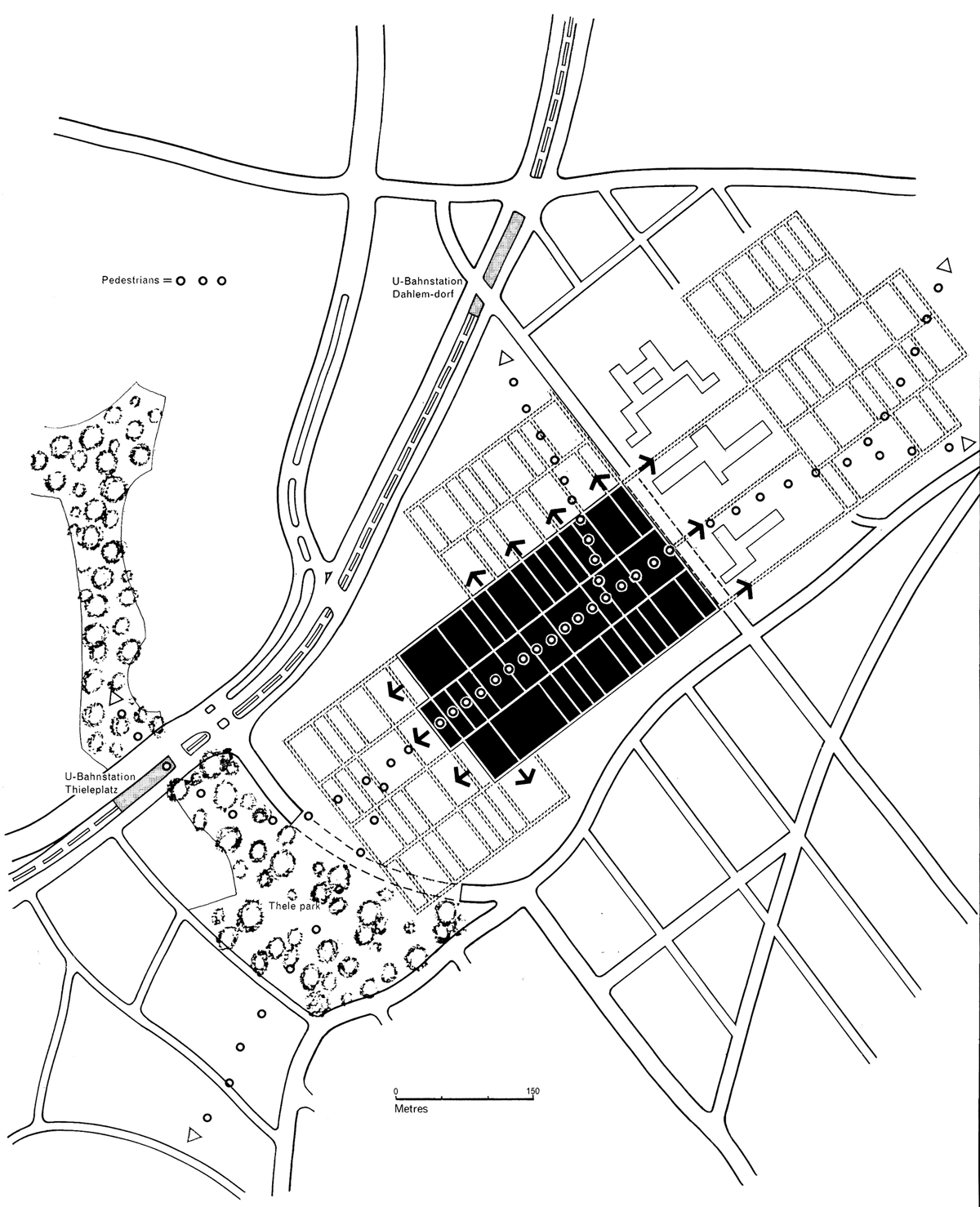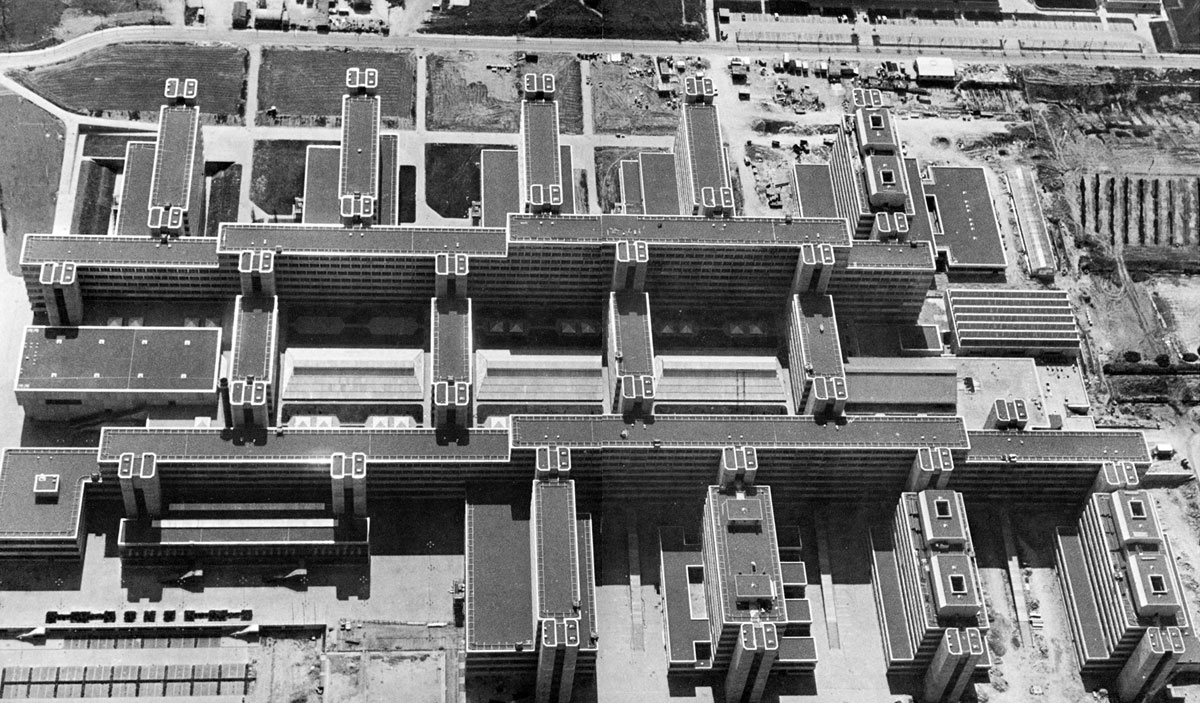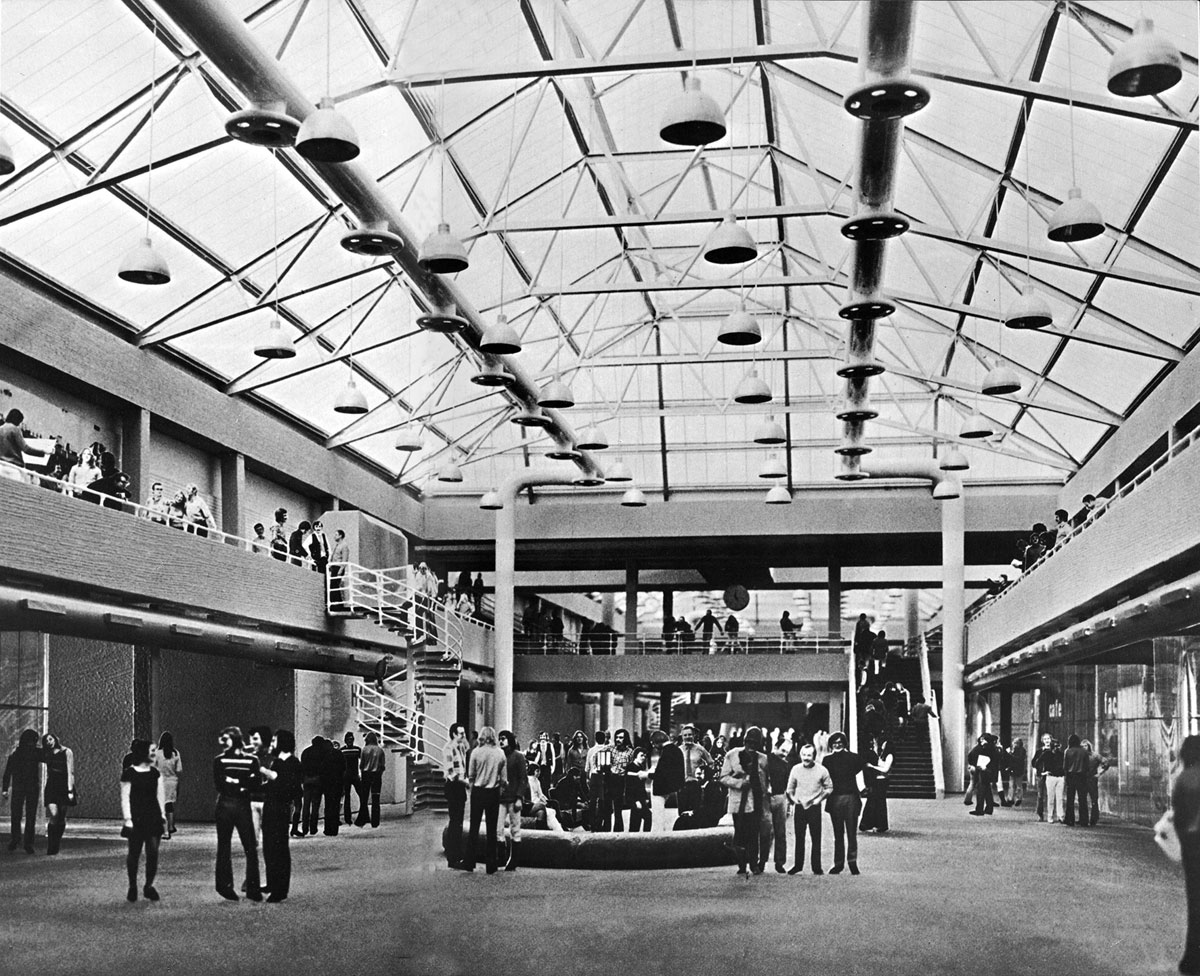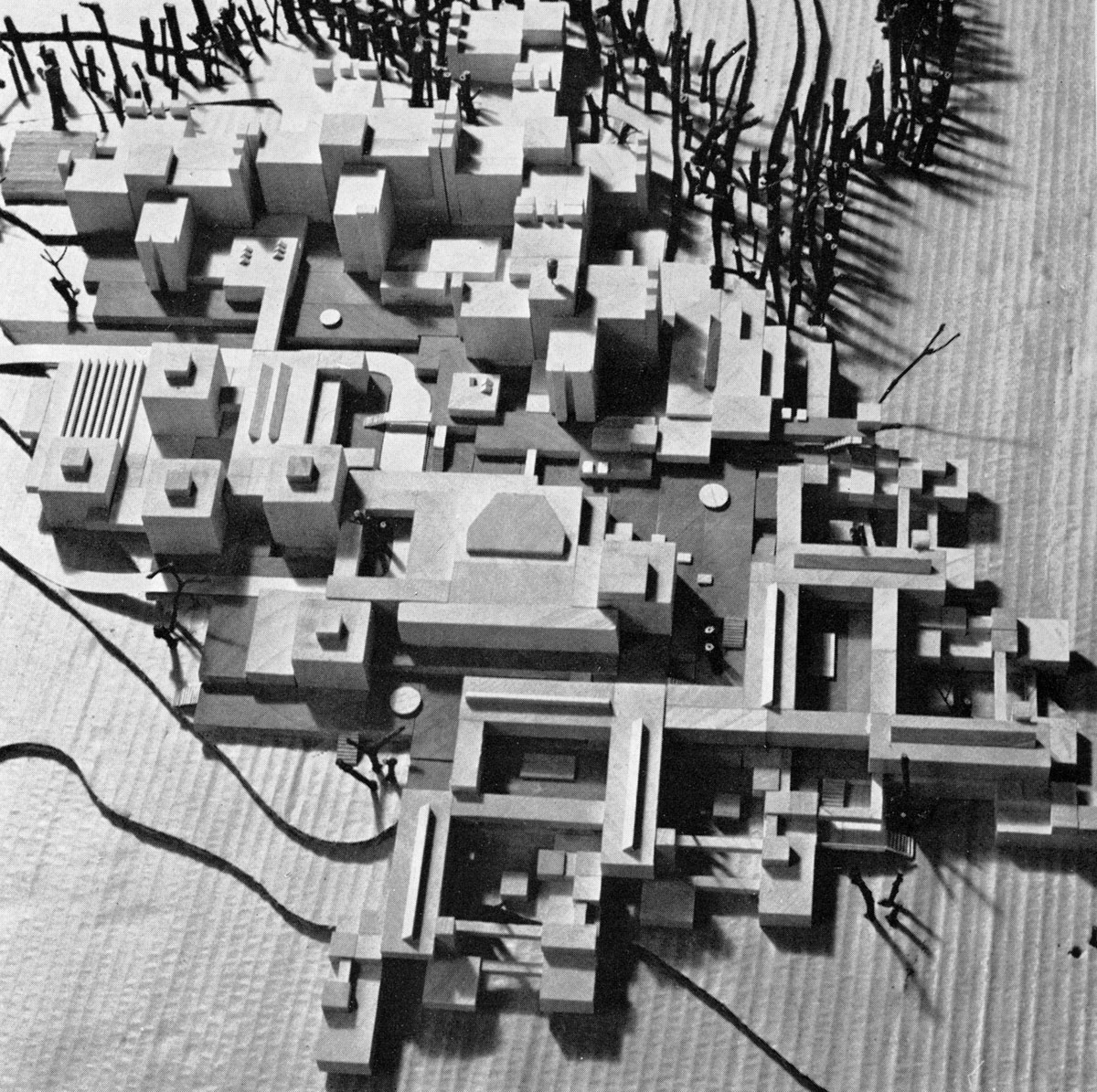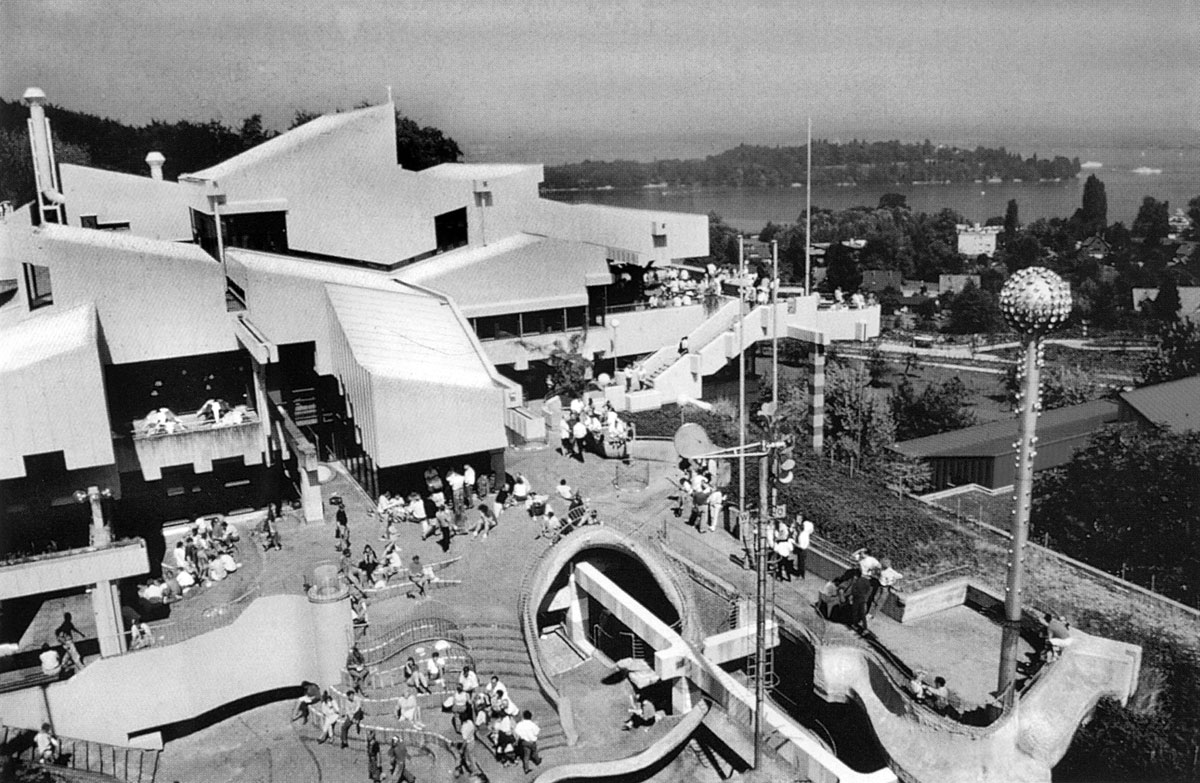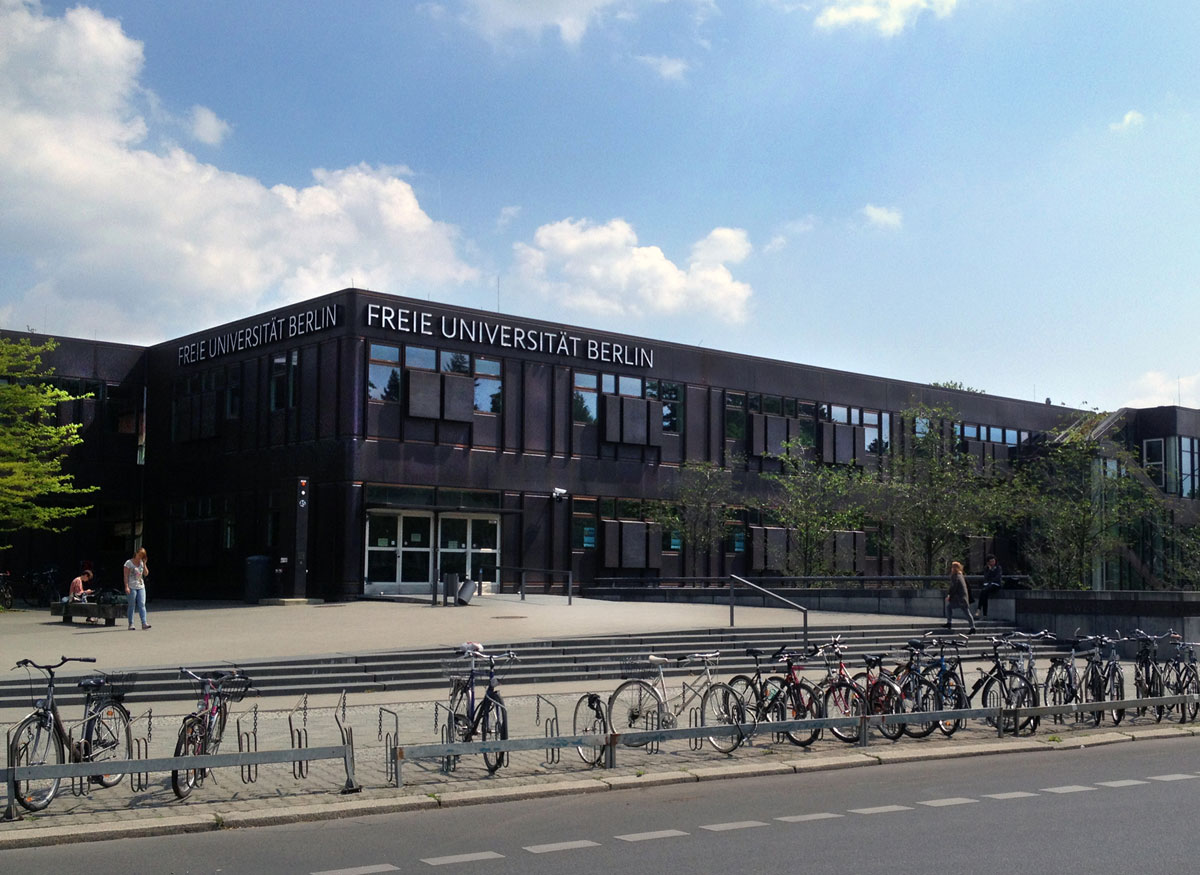Introduction
At a conference of the Association of German Architects (BDA) in 1971, Klaus von Dohnanyi, the German federal minister for education and science, set out his expectations for the ongoing university building programme: ‘Here will be constructed, with huge tax contributions, the buildings in which our children are to develop into free and well-informed citizens’. With these words Dohnanyi, a Social Democrat, summed up the chosen policy framework in a nutshell: ‘We need these buildings quickly, and enough of them at the lowest possible price’ (1972: 184).1
The first striking thing that a look at university architecture in West Germany reveals is the total construction volume: a great number of projects of great size. Seldom has university architecture seen such a boom as in the Federal Republic of Germany after World War II. By the mid-1980s, 38 new universities had been founded, while 27 old universities that remained on the reduced national territory had increased their student enrolment numbers (Framheim 1986: 157; Mayr 1979: 26).2 The university locations were distributed quite evenly over the country, corresponding to the Republic’s federal character, without a dominant centre (Figure 1).
Yet West Germany’s new ‘universities for the masses’ have not been comprehensively outlined as an architectural phenomenon. The intention of this article is thus to draw a first sketch. The concept of Massenuniversität was first formulated by Karl Jaspers, who elaborated his ideas on the institution of the university in the face of increasing specialisation in the modern mass society (Jaspers and Rossmann 1961), allegedly influenced by Elias Canetti’s Crowds and Power (1960; 1962). Although the general architectural debate on university architecture was going on at the international level, the situation in the Federal Republic of Germany was quite particular and therefore deserves special attention (Muthesius 2000; Paulus 2010).
Recent years have witnessed renewed interest in university architecture, the reasons for which are tangible: fifty years after the founding of these universities, many buildings are now receiving critical appraisal while deteriorating and awaiting renovation at the same time (Figure 2). At the time of writing, extensive renovation work is taking place in Bochum and Bielefeld, which will involve substantial architectural losses and will change the appearance of the buildings. Despite the more general aesthetic reservations concerning the architecture of the 1960s and 70s, which are still widespread, the university buildings in Bochum, Konstanz and Marburg have been listed as monuments in recent years, while the monument authorities in Bielefeld and Berlin have decided against similar listings (Hnilica 2017). If it is not (or at least not primarily) their aesthetic qualities, what else is it that makes the architecture of these new universities worth studying?
I begin by looking at the general conditions to highlight the political ambitions behind the sheer number and extraordinary size of the projects, from 1962 to the mid-1980s. However, it is not only quantity that matters but also the new conceptual qualities of university architecture. Therefore, while drawing connections to additional examples, I concentrate on the universities in Bochum, Marburg, Berlin, Bielefeld and Konstanz where those new ideas become particularly clear.
A comparative view reveals that two theoretical concepts were of outstanding importance in university design: the ‘building system’ and the ‘megastructure’. My primary aim in this article is hence to highlight how university architecture relates to those central concepts that emerged in the 1960s, drawing on my previous studies (Hnilica and Jager 2012; 2015; Hnilica 2014). The particular complexes discussed here have already been the subject of extensive research: several recent and comprehensive studies on the universities in Bochum (Jöchner, Hoppe-Sailer and Schmitz 2015), Marburg (Langenberg 2013), Bielefeld (Weisner 1994; Braungart 2009) and Konstanz (Kieser 2010; Schmedding and Marlin 2016) and the Freie Universität Berlin (Kiem 2008) provide excellent information on their individual building histories. But when focusing on single cases, one can hardly recognise the full extent of the underlying theoretical discourses. To give just two examples, Kiem names ‘growth and change’ as design-determining factors for the Freie Universität Berlin (2008: 114), but draws no connection to systems theory, and the same goes for Langenberg (2012: 78). I argue that the campus designs provide another key to the urban utopias that were formulated around the same time: the architects of the universities searched for a new kind of complexity in architecture, one that would accommodate large numbers of people while also reacting to individual needs.
Major Investments in the Future and Building on a Large Scale
How did specific university complexes relate to the broader urban utopias and ongoing political debates? To get closer to this question, we need to embed the architecture of mass universities in a more general discourse, a phenomenon I characterise as ‘thinking in large-scale structures’. Alongside the universities, such structures included housing estates, conference centres, corporate headquarters and shopping centres. Friedrich Spengelin, an important figure in the architectural debates in Germany during the 1960s, retrospectively stressed the importance of size in the architecture of the era: ‘The roads were big, the schools were big, the houses were big, everything was big. Progress always had to be big’ (Kampffmeyer, Spengelin and Siedler 1985: 334). The propensity for size corresponded to a modernist world view that was characterised by a belief in technical progress. There was a feeling that the revolutionary new ways of construction would replace traditional towns and cities. The large-scale university buildings discussed here are, in that sense, among the most significant implementations of urban utopias of the 1960s — even on the international stage (Hnilica 2018). Some contemporaries had already reached this conclusion. Chris Abel, for example, writing in the British journal Architectural Design, dubbed the German university building to be the world’s best-judged realisation of the megastructure concept. Talking about the extension of the Freie Universität in Berlin-Dahlem, at that time under construction, Abel pronounced it nothing less than a model for the ‘city of the future’ (1968: 546).
The architects and their theories offer only one side of the story, though. The fast-expanding economy of West Germany, which was creating a huge demand for highly skilled employees, was overloading the capacity of traditional universities. Behind the calls for broader access to higher education in the early 1960s were considerations of how to mobilise so-called ‘educational reserves’ to boost the economy (e.g., Picht 1964). A political shift following the change from the Grand Coalition, led by the Christian Democratic Union party, to a social-liberal government in 1969 put greater emphasis on socio-political issues in education. The liberal politician and sociologist Ralf Dahrendorf, for example, called for ‘education as a civil right’, exhorting the government to create equal opportunities for all, and described any higher education envisioned as a privilege for the upper classes as a threat to democracy (1965). This conviction made the building of ‘universities for the masses’ one of the major projects of Germany’s social-democratic Wirtschaftswunder.
Some years before, the German Council of Science and Humanities had advocated the founding of ‘relief universities’ (Wissenschaftsrat 1960). The federal government responded with the 1969 University Building Promotion Law (Hochschulbauförderungsgesetz, BGBl 1969: 1556), among other measures. The buildings for all the newly founded universities were to be constructed from scratch. In its ‘Recommendations … on the Expansion of Academic Universities’, the German Council of Science and Humanities advised firmly against the conversion of existing buildings, as new buildings were thought to be more economical (Wissenschaftsrat 1967: 154).
In addition, as will be shown below, it seemed more fitting to house innovative universities in innovative, new buildings. This represented a break with tradition. Previously, newly founded universities in Germany had often been housed in existing structures. Historical examples of adaptive reuse include the universities in Marburg (established in 1527) and Kiel (1665), which moved into abandoned monasteries, or Berlin (1810) and Bonn (1818), which were located in former palaces. This tradition of ‘thrifty integration’ was continued during the years immediately after World War II, when abandoned army barracks were converted into universities in Saarbrücken and Mainz, while the Universität Münster, which had lost its buildings in the bombings, moved to the prince-bishop’s palace (Nägelke 2000: 20).
Between 1949, the year of the currency reform, and 1967, the federal and state governments invested 7.7 billion deutsche marks (DM) in university construction (BBW 1969: 11). In the following years, things really took off. The 1969 University Building Promotion Law established the construction of university buildings as the joint responsibility of Germany’s central and federal state governments, and these invested a total of 37.7 billion DM between 1970 and 1985 (PH 1985: 28–31). When viewing these figures, it is important to bear in mind that most of the complexes that were designed in the 1960s were actually built during the 1970s; usually the universities started teaching in provisional buildings during ongoing construction work. The greatest building activity was recorded in North Rhine-Westphalia, where 14 new universities were built at a cost of almost 11 billion DM and equated to a total of 1.5 million square metres of new academic space (Jacobsen 1984; Langenberg 2006: 97). The usable area of German university buildings increased sevenfold over 30 years (ca. 1960–89), laying the physical foundations for a tenfold increase in the number of students over the same period (1,336,395 students in 1985) (Lundgreen 2008: 262).
In addition to ‘relieving’ (Entlastung) the overcrowded traditional universities, the Council of Science and Humanities also intended to initiate more principal reforms of those hierarchically structured institutions (Wissenschaftsrat 1967: 35). In fact, the founding of new universities enabled an ‘experimental field for the attempts at reform in higher education policy’ (Rudloff 2007: 78). The universities struggled for democratisation and accessibility, away from the elitist ‘scholarly republic’ and towards democratic mass institutions. The reforms sought both to dismantle the hierarchies that existed between lecturers and students and to connect the compartmentalised academic disciplines. This was to be reflected in the newly founded Reformuniversitäten and Gesamthochschulen (‘reform’ and ‘comprehensive’ universities).
The new academic spirit was to be reflected in a new kind of urban layout. There was a conscious movement away from the small-scale buildings of traditional universities such as in Marburg, Tübingen and Heidelberg, where the academic institutions were inextricably linked in spatial terms to the generally small ‘university’ towns (Universitätsstädte) that hosted them. This traditional socio-spatial mix was now regarded as limiting and outdated.
The architects tasked with building the new universities found their role models not so much during their study trips to universities in the USA and Great Britain (although they made such trips; see, e.g., Eller 2015: 84), but by looking at urban designs for other projects. Throughout the 1960s, the concentration processes at work in highly industrialised capitalist societies became a model for the organisation of all areas of society, made especially possible in large building complexes. Optimising internal processes appeared to be the right solution, whether in transport logistics, art, habitation, health or knowledge production. There were even calls to house entire city centres within a single building.
Fridolin Hallauer, the highest-ranking building officer of North Rhine-Westphalia, played a key role in shaping building policy for the new universities and compared them with ‘production sites’ that had to be optimised in order to ‘achieve a maximum of efficiency and a minimum of production and resource expenditure’. The result could only be a large, contiguous complex ‘that takes place on an undivided site in areas of urban dimensions’ (1970: 57). Thus envisioned, the new universities were organised as large-scale structures on the periphery of larger cities, located literally on the greenfield. This applied equally to the large-scale expansions of some traditional universities, such as the Lahnberge in Marburg and the Neuenheimer Feld in Heidelberg.
It is worth turning for a moment from evaluating the architecture in qualitative terms to recognise that, within only two decades, the Federal Republic of Germany had succeeded in giving large parts of the population access to higher education. The new universities, with their enormous construction volumes, were a feat of financial, technological and organisational prowess. Setting aside the architectural and urban planning qualities or shortcomings of the individual buildings, the fact that these universities existed in the first place — and are to this day accessible and free of major tuition fees — was a major sign of democratisation.
The similarities to the industrialised mass housing of the post-war decades are obvious. Numerous large-scale housing estates were built on the outskirts of cities, many of which are viewed critically today. But here, too, the successes should not be underestimated: within a few decades, ‘one’s own four walls’ went from being an individual luxury good to a mass article available to people from all strata of the population. As with the right to decent housing, the right to education was understood as a central political task.
An Industrial Megaform and Its Realisation in Bochum
The Ruhr-Universität in Bochum, founded in 1961, was a truly spectacular starting point. It was to be ‘big’ — that was emphasised quite explicitly — in order to allow the great mass of working-class children from the Ruhr region access to a ‘“new type” of university’. The founding committee in Bochum drew an organisational chart that grouped the four faculties — humanities, natural sciences, engineering and medicine — around a central axis containing shared facilities. In an idiosyncratic interpretation of Wilhelm von Humboldt’s idea of the unity of science, the committee strove to achieve a ‘unity of science under one roof — almost in one single building’ (Hallauer 1965: 15). This striving for interdisciplinary communication became a guiding theme in the university policy of the era (Schregel 2016).
In 1962, a design competition was organised, and prominent international architects like Walter Gropius and Bakema & van den Broek participated (Wettbewerb 1963; Apfelbaum and Schmitz 2015). First place was awarded to Hentrich, Petschnigg & Partner (HPP) from Düsseldorf, who were on their way to becoming one of the most important office tower architects in West Germany. However, their design was merged with another by the local State Building Authority (Staatshochbauamt). It was during this process that the complex acquired its characteristic density and compactness (Hnilica and Jager 2015: 100). In effect, the organisational chart was transposed directly onto the building layout (Figure 3). Two rows of high-rise slab blocks stand on a huge base measuring a kilometre in length, which contains further teaching rooms and a large car park. Each of the 13 almost identical academic department buildings is 110 metres long and comprises 8 to 13 storeys. The central facilities (the library, canteen and main auditorium) form a transverse axis. In contrast to American campus universities, no one lives on the Bochum campus. As elsewhere in Germany, most students continue to live with their parents to save costs. Thus, the principle of the car-friendly campus was born with the very first newly founded university.
Organisational chart and final layout of the Ruhr-Universität Bochum by HPP et al., 1962/63 (Ruhr-universität 1965: 334 and 416).
In technical terms the work was pioneering. Fritz Eller, a partner at HPP who had been responsible for the Ruhr-Universität project alongside Erich Moser and Robert Walter, did extensive research to determine the space requirements (1965). The building volume was titanic, the budget and the timeframe extremely tight, and labour difficult to come by. Industrialised construction used prefabricated components; the whole complex was based on a 7.5 metre by 7.5 metre grid, and the concrete floor panels were fabricated on site.
The Ruhr-Universität was an architectural feat of strength. Admittedly, the design repertoire did not really reflect the architectural zeitgeist in Germany, especially as monumental forms, straight axes and symmetry tended to be associated with the Nazi period. Michael Naumann, the future publisher of Die Zeit, had spent his younger years working as a teaching assistant in Bochum and in a review, disparaged the university’s monumental axis as ‘Mussolini-like’ (Naumann 1974). But in the long run, it seems that it was exactly the formal austerity, along with classical compositional principles such as the closed form, repetition and symmetry, that made the design so monumental. What emerged was an iconic, rationally organised Großform (Figure 4).
Ruhr-Universität Bochum (1962–84), by HPP et al. Aerial view, 1974 (Ullmann 1978a: 26).
Other architects were looking for modern grand gestures as an alternative to classical monumental building traditions. Otto Ernst Schweizer (1957) had coined the term architectural Großform, which could be translated as ‘megaform’. Oswald Mathias Ungers (1966), who had studied with Schweizer, adopted the term a few years later to help formulate a guiding principle for large-scale housing estates. He argued that such large building volumes could only be organised by means of strong forms. Interestingly, Ungers’ idea was strongly influenced by gestalt theory: he stated that strong forms needed to be recognisable, with a clear motif, with all elements similar and interconnected (Mühlthaler 2007; Hnilica 2018: 114). Such an organising and identity-forming motif was clearly given in Bochum. Hildegard Hamm-Brücher, a well-known Free Democratic Party politician, interpreted the emblematic architecture of the Ruhr-Universität as a ‘shipyard’, with ‘ultra-modern, giant ocean liners lying in dry dock awaiting launch’, thus evoking the symbolism of modern universities as great ships ready to set sail into the democratic society (1965).
The Theory of Complex Systems and the Marburg Building System
At the same time as in Bochum, plans for a large-scale expansion of the venerable Universität Marburg were on the drawing board. The project is typical of the greenfield expansions that took into account the results of the university reforms. The plan was to build a 250-hectare campus for medicine and the natural sciences in a hilly area close to the river Lahn. A University Building Authority (Universitäts-Neubauamt) was set up in 1961, headed by Kurt Schneider. The team was joined by the young architect Helmut Spieker, who since his student days had been searching for the perfect building system that could be used anywhere, for any purpose (1989). Spieker would be able to try out his ideas in Marburg.
All university buildings of the 1960s and ’70s were largely constructed from prefabricated elements, and system-based building has been widely discussed by architecture historians in recent years. But there is a level of meaning in system-based building that is all too often overlooked: given its size, dynamics and vagueness, the task of building such a complex thing as a university naturally lends itself to a systems theory interpretation. Ludwig von Bertalanffy, who began formulating his ideas of ‘general systems theory’ at the end of the 1930s, sought universal principles that would apply to all types of systems comprising a large number of interacting elements, regardless of whether they were social groups, ecosystems or computer networks (1968). In 1947, Norbert Wiener coined the term ‘cybernetics’ to describe data processing in adaptive systems that maintain a so-called dynamic balance by means of feedback control loops (1962: 11). The theory of ‘complex systems’ is particularly interesting in our context as interactions between the elements are non-linear and therefore more difficult to predict.
Referring to systems theory, the University Building Authority in Marburg chose a completely different path than the architects in Bochum. They described the task as being ‘to find an appropriate form for something that is constantly changing, for something that is unknown, not only in the future but also in the present’ (Schneider et al. 1964: 848). Functionalist planning is only possible if the functions can be clearly defined. Therefore, Schneider and his colleagues did not start by designing a master plan but decided instead to develop a university building system. They hoped that a perfect system would allow ultimate flexibility: in planning and construction, but above all in later use.
According to the architects, industrial construction required a ‘total grid system’ (Schneider et al. 1964: 862). Master plan and column grid, room height, stair step and drawer front — every element was subordinated to a very rigid grid system (UNM 1971). The panels for the primary structure measured 7.2 by 7.2 metres. The load-bearing system consisted almost entirely of square reinforced ‘concrete tables’ that could be stacked up to eight storeys high (Figure 5).
The ‘Marburg Building System’ by the University Building Authority in Marburg. Isometric view of the precast concrete elements, 1963 (Schneider et al. 1964: 851).
The exposed concrete of the load-bearing ‘tables’ was combined with black-framed white wall panels, evoking traditional Japanese architecture, which was a model for many modern architects because of its strictly modular structure (Figure 6).
Medical laboratory buildings at the Lahnberge Campus Marburg (1961–77), by the University Building Authority (Schneider et al. 1965: 1399).
In structural terms, the desire for flexibility generated many problems: for example, the possibility of turning every internal wall into an external wall and vice versa proved problematic for building physics. Schneider’s team launched an international competition among construction firms and worked through numerous alternatives. Moreover, all builders’ joinery and carpentry components were to be designed from scratch, and suppliers were obliged to hold stocks of their components for decades to come to meet any future expansion requirements (Langenberg 2012: 79).
Flexible or not, there had to be some kind of a master plan, or at least an initial stage. Surprisingly, unlike the Ruhr-Universität, the Marburg campus is not a composed Großform. In fact, it might more accurately be described as a huge pile of building blocks (Figure 7). At first sight, the amorphous form appears to contradict the strict rationality of the square grid, though it does follow a certain, albeit unspoken, logic. The idea was that the entire ‘complex system’ should be able to grow or shrink as required, almost from within itself. The clustered forms were intended to imitate an organic growth process.
Master plan for the new campus at the Universität Marburg, by the University Building Authority in Marburg, 1963 (Schneider et al. 1964: 848).
At the beginning, construction plans in Marburg were highly ambitious. The buildings were to be as flexible and dynamic as science itself: the task was not to design the building but to provide a building kit. As one reviewer explained in the Frankfurter Allgemeine Zeitung, ‘The inventor of the Marburg Stilt Building claims not to provide a building type, but only a structure that can be changed in any sense, even shrunkʼ (Schulz 1972: 4). This type of university construction set a trend for the whole construction industry. Soon architects were devising similar building systems for entire cities. In 1965, Richard J. Dietrich, another devotee of systems theory, began to develop his ‘METASTADT’ building system; a prototype was constructed in Wulfen in the early 1970s, but it soon proved unsuccessful (Hnilica 2018: 158–62).
Despite all efforts, the campus remained incomplete. Due to financial problems, only a fraction (approximately 25,000 m2) of the planned 620,000 m2 was actually built, which meant that social life on the campus could never really develop. The Marburg Building System, perfected at great effort, similarly defied all expectation and was never used to build other universities. Nevertheless, it achieved fame.
The difficulties in Marburg did not lead to a departure from modular systems in university building. In fact, all further campus designs discussed here were to move between the initial two poles: the well-ordered megaform of Bochum and the open system of Marburg. Other building systems followed, such as the one known as NRW 75, which was introduced in North Rhine-Westphalia in 1972 under the leadership of the aforementioned Fridolin Hallauer (1978). The NRW 75 system was used between 1972 and 1985 for the construction of five new universities: Essen, Paderborn, Siegen, Wuppertal and Duisburg.
Megastructure at the Freie Universität Berlin
The design of the Freie Universität Berlin has received the most international recognition as a so-called megastructure. ‘Structuralism’ in architecture refers to a movement that is quite diverse. In addition to the architect of the Freie Universität Berlin, Shadrach Woods, its protagonists included Team X members Aldo van Eyck and Alison and Peter Smithson, among others. Team X came to the fore at the 10th CIAM Congress in Otterlo in 1959, where functionalism was criticised. Interestingly, debates on structuralism in architecture rarely involve detailed references to philosophical approaches, although the works of the French structuralist philosophers were well received in Germany because they were linked to Marxist theories. Those highly abstract treatises, however, probably had more of an enigmatic than a clarifying effect on the architects, who were usually not philosophically educated. In Woods’s design for the Freie Universität Berlin, this resulted in some ‘creative misunderstandings’, according to Anne Kockelkorn (2011: 160).
The fact that ‘structure’ is also a key concept in systems theory leads to a far more convincing interpretation of Woods’s intentions. When order emerges in a complex system that initially appears chaotic, this is referred to as ‘structure formation’. In architecture, the term ‘structure’ is therefore difficult to pin down, as it can be interpreted in a number of different ways, to mean both ‘pattern’ and ‘framework’ or even the structural skeleton of a building. It may also suggest the notion of ‘infrastructure’, a term that was very important in the architectural debate in the 1960s as a link between spatial and design concerns and socio-economic considerations (Laak 1999).
Combining all these different notions, the ‘megastructure’ became a key concept in architectural discourse and urban planning in the 1960s. It gained wide circulation after the World Design Conference in Tokyo in 1960, where a group of young Japanese architects grouped around Kenzo Tange presented an astonished international public with urban utopias. His design for bold urban expansion in Tokyo Bay caused a particular sensation: its basic framework was a chain of elevated highways and maglev tracks, forming a giant ‘civic axis’ stretching across the bay, surrounded by huge residential hills hovering on platforms (Tange et al. 1961). According to Tange, there were to be life cycles at different speeds. The ‘large’ structure was intended to be permanent and to be filled with small, short-lived add-on elements, such as a huge set of shelves.
In the words of Fumihiko Maki, ‘The megastructure is a large frame in which all functions of a city or a part of a city are housed. It has been made possible by present day technology’. The add-ons would meet the individual needs of the inhabitants, while the permanent framework would be designed by architects. Within the stable ‘master form’ there could be constant change while maintaining a recognisable structure (Maki 1964: 8, 10–11; italics mine). Maki and Tange were taking some of the basic principles of systems theory and merging them with the idea of an ordering principle or gestalt.
Subsequently, utopian urban designs in the same spirit sprang up around the world, including those by Yona Friedman, Archigram and Paul Rudolph. A proponent of this movement in Germany was Eckhard Schulze-Fielitz, who developed a megastructure with small add-on units for the university idea competition in Bochum (Strauß 2005: 161, 213; Figure 8). His proposal was considered utopic (and was thus excluded from the competition).
Competition entry for the Ruhr-Universität Bochum by Eckhard Schulze-Fielitz, photo collage, 1962 (Baukunstarchiv NRW).
Only one year later, Shadrach Woods won the idea competition for the Freie Universität Berlin with a megastructure approach. Working in a collective architectural firm with Georges Candilis and Alexis Josic, Woods developed the design with his German colleague Manfred Schiedhelm, who also oversaw the construction work (Kiem 2008). The jury that made this bold selection was chaired by Horst Linde, professor for university building in Stuttgart, where he headed both the ‘university building’ collaborative research centre and Germany’s Central Archive for University Building (Zentralarchiv für Hochschulbau). The model devised by the architects for the competition in Berlin perfectly exemplified their design concept (Figure 9). It was an abstract structure that represented neither construction techniques nor façades. There was simply a number of parallel pathways along which spaces for various functions were distributed, interspersed with patios.
Competition entry for the new Freie Universität Berlin in Dahlem by Shadrach Woods et al., cardboard model, 1963 (Joedicke 1968: 211).
In contrast to Schulze-Fielitz’s project for the Ruhr-Universität Bochum, Woods’s design for Berlin does not quite correspond to the definition of a megastructure at first sight. There is no literal large frame: the Berlin building spreads out like a carpet. Yet the references to Maki’s definition of a megastructure are strong. In his own words, Woods designed a ‘general framework’ within which spontaneous centres would form over time (Figure 10; Joedicke 1968: 208). Woods explained that he had designed not a megastructure, but a ‘minimal structure’ (1965: 114). By ‘structure’, Woods meant a system of internal order, more specifically the floor layout and circulation plan, as opposed to a load-bearing skeleton (1964: 154). He referred expressly to the theory of open systems and stressed the importance of the role played by the users as they change a structure over time. This emphatically anti-monumental structure reflected programmatically what was expected of the institution: there were to be no hierarchies in the layout of the building; users were to be able to modify all the rooms as they wanted, freely, democratically and on a self-organising basis.
Diagrams explaining the design idea for the Freie Universität Berlin by Shadrach Woods et al., 1963 (Joedicke 1968: 208).
The façade was designed by Jean Prouvé using Corten steel components, which earned the building its ‘rusty arbor’ (Rostlaube) nickname (Figure 11). The second building phase was designed by Schiedhelm after Woods’s death in 1973, with a façade in anodised aluminium and dubbed the ‘silver arbor’ (Silberlaube).
Humanities department building at the Freie Universität Berlin (1963–82), interior courtyard with Corten steel façades, 1973 (Nestler and Bode 1976).
Despite various problems, especially with building physics, the building had secured its reputation in the architectural world before it was even completed. Meant to behave like a city district, it was seen as paving the way for a new architectural understanding. Woods declared that its model was the uniformly geometric street grid of Manhattan, in which individual plots and entire blocks could be developed and used with few constraints (1967: 115; Woods and Vailland 1967: 56). In formal terms, the design had been inspired by Woods’s recent unrealised competition entry for the redevelopment of the former historic city centre of Frankfurt am Main (Kampffmeyer and Weiss 1964: 73).
Already during construction work, Woods explained how he imagined making the construction process a collective enterprise while the building itself would continue to ‘grow’ over the course of time within the original order (Figure 12):
We have already been asked if we would mind if [the author of the design that came fourth in the competition, Walter] Schwagenscheidt and others did a bit of it. We do not mind. It would be very fine to get a lot of architects working within the system. You could then immediately tell when you go from a Schwagenscheidt into a Candilis portion. But this is a problem we are faced with even in our cities. (Woods 1967: 115)
Expansion plan for the Freie Universität Berlin by Shadrach Woods (1967: 117).
Alongside Bochum and Berlin, spectacular university competitions followed elsewhere. The ideas competition for Bremen University in 1967 called for an ‘urban Großform’ that would allow ‘any form of expansion’ while continuing to provide a clear ‘organisational order’ (Universität Bremen 1967: 4). This was another starting point for creating megastructures. The most extreme of the 128 entries came from Lyubomir Szabó (Figure 13). Rather than a building, he (quite literally) proposed a large frame, like the terminal of a container port, in which cranes would continue moving and rearranging portable cabins. Szabó intended no less than a ‘new type of material, man and energy supply system’, consisting of ‘mobile crane equipment with synoptic, mobile, on-site production facilities for an axiomatic understanding of growing large-scale campus teaching centres’. He dreamt of a ‘new type of topological conglomerate of building and learning processes’ (1970).
Diagrammatic section from the competition entry for the Universität Bremen by Lyubomir Szabó, working with Wolfgang Rathke and Heinz Behrendt, 1967 (Conrads 1967: 1056).
Szabó’s design was inspired by the Potteries Thinkbelt project published by British architect Cedric Price (1966) a year earlier. To the deep disappointment of the progressive architects, the Bremen jury awarded the first prize to a more conventional design. This frustration was also articulated in the much-read journal Bauwelt, where Szabó, alongside Helmut Spieker and others, engaged in a debate with the journal’s editor-in-chief, Ulrich Conrads (1967; Hnilica 2014: 223–24). They felt static architecture was outdated, explicitly referring to systems theory.
Rationally Organised Megaform vs. Organically Grown City: Bielefeld and Konstanz
Soon things changed, and the belief in perfectly flexible and dynamic building systems began to wane again, whereas large structures continued to be built. While numerous other university designs were the result of rather pragmatic decisions, two more outstanding projects need to be mentioned: the so-called Reformuniversitäten that were founded in Bielefeld and Konstanz, where the initial conditions were quite similar, but the architectonic solutions were not.
One of the masterminds behind the founding concept in Bielefeld was the founding rector and sociologist Helmut Schelsky, who wanted ‘to organise research in a very modern, rational form’ (1966: 37). He emphasised rationalisation and interdisciplinary collaboration. Schelsky had prepared the ground for the introduction of systems theory into the social sciences — among other things through his personnel policy, whereby he appointed Niklas Luhmann in 1968 as the first professor at the new university. This is where Luhmann developed his theory of social systems (Hnilica 2014: 227).
Nevertheless, building systems played less of a role in the design of the actual university building. A young team of four unknown architects — Klaus Köpke, Katte Töpper, Wolf Siepmann and Helmut Herzog (who had only just graduated) — won the 1967 competition in Bielefeld with an extremely compact, rationally organised Großform (Figure 14). The huge complex measures 450 metres in length and its architectural backbone is a 240-metre-long, glass-ceilinged hall (Köpke, Kulka and Töpper 1976: 375). This hall, a mix of atrium and inner street, as in a mall or hotel complex, connects two rows of high-rise academic buildings. Dietrich Storbeck has called universities like Bielefeld ‘large-scale academic enterprises’ (‘wissenschaftliche Großbetriebe’), referring to the efficient spatial organisation similar to factory plants (1975: 13).
Universität Bielefeld by Klaus Köpke, Peter Kulka and Katte Töpper et al., aerial photograph, 1975 (Personal archive of Klaus Köpke).
Indeed, the building organises communication by architectural means: first, through the inner street and second, through a ring of jointly used libraries running around the hall, connecting the knowledge from the different departments. The spatial arrangement works very well. As Bielefeld academics certified, the university’s hall exerts ‘almost a compulsion to communicate’ (Braungart 2009: 53) (Figure 15). Though Schelsky was only ever able to implement his ideas to a limited extent (so great was the resistance he faced that he withdrew, embittered, from the project), he nevertheless left his mark on the organisation of the institution and the building.
Universität Bielefeld. Model of the central hall by Klaus Köpke, Peter Kulka and Katte Töpper et al., 1975. Personal archive of Klaus Köpke.
Despite the building’s sucesses, there were downsides as well, both in terms of its location in the city and the architecture. The Bielefeld campus optimises inward communication while closing the university off from the outside world: the academic community is cut off from the city. Giancarlo de Carlo very aptly described the building as a ‘suburban citadel’ (1976: 42).
A counterpart can be found in the Reformuniversität Konstanz, which, despite similar ambitions, was designed in a rather different process. A round table procedure brought various players together in a long discussion (Kieser 2010; Schmedding and Marlin 2016). The University Building Authority Konstanz (Universitätshochbauamt), under the direction of Wenzeslaus Ritter von Mann from 1967 to 1969, authorised the final design. Interdisciplinarity and communication were the guiding principles in Konstanz as well, resulting in a central library and a forum echoing the Bielefeld programme. At 350 metres long, the Konstanz ensemble is only slightly smaller.
In terms of its formal design, however, the building of the University of Konstanz could hardly be more different. Ritter von Mann described the design as an ‘interwoven structure’ (1969: 138). Eschewing long axes and right angles, the planners opted for an irregular cluster (Figure 16). The units are piled up and grouped around a central forum with curves and slopes (Ullmann 1978b). The design is reminiscent of the attempts to concentrate entire city centres in one large structure, such as the Nordwestzentrum in Frankfurt am Main (1962–68, designed by ABB; see Hnilica 2018: 54–58). Project architect Wilhelm von Wolff explained that the idea in Konstanz was indeed for people to ‘wander through the university as if in an old town; there were to be squares and alleyways for informal meetings, perhaps a little mystery here and there to raise expectations’ (quoted by Kieser 2010: 267). The architecture mimics a picturesque medieval mountain town, full of nooks and crannies, using a wide variety of materials and playful details.
Model of the Universität Konstanz (1964–84) by the University Building Authority Konstanz, 1969 (DASL 1970: 421).
In this respect the Konstanz buildings made use of organic qualities and complex geometric forms resonant of broader interests developing among architects of the 1960s who had become fascinated not only by ‘organically grown’ complex systems but also by ‘organically grown’ vernacular architecture: Bernard Rudofsky, to cite just one example, curated the famous Architecture without Architects exhibition at MoMA in New York, highlighting the beauty of traditional settlements (1964).
In Konstanz, this organic quality was, however, exclusively formal; there was no attempt to enable actual changes like in Berlin or Marburg. The intention was to orchestrate the sort of spontaneity that characterises the creative process; there is an obvious correspondence between academic ideals and the choice of architectural means. A contemporary critic gave this appreciative verdict: ‘Every detail is shaped by the intention to provoke as much chance, spontaneity and disturbance, as much stimulation and breadth of experience as possible’ (Kammerer 1975: 139). Instead of the scientific rationality emphasised in Bielefeld, Konstanz promoted creativity and a playful spirit of discovery (Figure 17). The brightly coloured architecture bespeaks a revolt against the ubiquitous grid system introduced in Bochum, for example.
The forum at the Universität Konstanz, aerial photograph, 1985 (Oettinger and Weidhase 1985).
Critical Appraisal and Future Prospects
What can we learn from these extremely large-scale buildings that were designed within a short time frame and with extraordinary ambitions? Higher education had been defined as a central political goal, and this goal was vigorously pursued with major investments. The building sites in Bochum and Bielefeld were the largest in all of West Germany at the time. From a scientific point of view, it seemed necessary to interconnect the university disciplines more closely by means of architecture. As the academic community was looking for a new framework for collaboration and teaching, the new designs went hand in hand with the modern logic of rationalisation. Government infrastructure measures proved a motor for the construction industry and a testing ground for modular architecture and structural urban design. In this situation, new ideas on scale and flexibility in architecture, based on gestalt theory and systems theory, were put forward.
The Ruhr-Universität in Bochum was the spectacular starting point, being the first mass university in West Germany to use industrial methods, placing a functionalist and iconic megaform in the open landscape. The new campus of the long-established Universität Marburg outside the city in the Lahn hills was also based on modularisation, but its amorphous master plan could not have looked more different. The resulting Marburg Building System was expected to change dynamically over the entire life cycle of the structure. All further campus designs were to move between these two poles: the iconic megaform and the growing building system.
Throughout the 1960s, university competitions offered many opportunities to produce utopian urban designs. The (mega)structure for the Freie Universität Berlin was strongly inspired by systems theory and was perceived internationally as groundbreaking. The design for the Universität Bielefeld of 1969 took up the idea of a functionalist megaform once again and pushed it to the extreme. The motif of concentration in one very compact, large building intensified. Meanwhile, in southern Germany, the first criticism of the basic idea of the large structure appeared in the layout of the Universität Konstanz. It was a compact building similar to Bielefeld, but in an irregular form, reminiscent of a medieval mountain town, with its many twists and turns.
All the campus plans discussed here are quite exemplary implementations of the dominant urban planning models. They all follow the modernist principle of the separation of functions, reflecting the state of the urban planning debate in Germany, as can be seen, for example, in the compendium Deutscher Städtebau 1968 (DASL 1970). The large-scale mono-functionality was consciously developed as a counter to traditional university towns such as Marburg and Heidelberg.
From today’s perspective, the mono-functionality and spatial separation of universities from town centres appears problematic, though. Open structures could theoretically integrate all possible functions in all kinds of combinations. For example, it would have been possible to mix university and habitation, or education and production. As architect Fritz Eller has soberly commented,
There was no university life [in Bochum] as it was once imagined there would be. There were no bars where you could go for a beer, etc. … The social event has not taken place. At the most, people meet up in the canteen. … Indeed, the difference between a business park and a university is getting smaller and smaller… (Eller 2015: 83)
By the mid-1970s, when construction work was still in full swing everywhere, the progress-minded euphoria of the 1960s had begun to cool. A new awareness of ‘The Limits to Growth’ was emerging (as in the famous title of a report issued by the Club of Rome, in Meadows et al. 1972). A general change in mood set in, leading to a critical attitude towards large-scale structures in general — and not based on architectonic form alone. The very scale of progress began to be perceived as delusional, inhuman and unreasonable. The negative aspects of the new universities had come to dominate discussions by then. The Ruhr-Universität in Bochum, so euphorically celebrated by Hamm-Brücher in 1965, was called, with building work still fully underway, ‘horror architecture’ by Naumann, who described the campus as monotonous, soul destroying, technocratic, an ‘intellectually repugnant monument to egoistical trumpet blowing, education-policy pretensions and architectural brutalism. … with concrete everywhere. It represses the way people walk, speak and think. … A brain factory’ (1974).
This negative perception continues to shape the view of post-war modernist architecture. The structural qualities of the architecture have been overlooked for a long time. Alongside building systems, the concept of the megastructure seemed particularly promising at first, combining the ordering design of the architect with more democratic, self-organising elements. Academic thinking and institutional organisation were equated with spatial structures inspired by the systems theory paradigm. Indeed, many of these flexible, adaptable elements of the buildings have never been utilised. Movable walls have rarely been relocated, stocks of spare parts have hardly ever been fitted, and unused spaces have never been reduced — regardless of the fact that the way the architects of the Marburg system thought about the convertibility of their buildings corresponds very well to today’s sustainability requirements (Hassler and d’Ayot 2009).
Yet the recent fate of the Freie Universität Berlin complex shows how rewarding a deeper understanding of systems and structures can be. Between 1997 and 2007, the entire complex, not yet 30 years old and displaying serious structural faults, was renovated and extended by Norman Foster (Figure 18). In 2004, Florian Nagler won a design competition for another extension, which simply continues the existing carpet of buildings. To the ‘rusty arbor’ and the ‘silver arbor’, a ‘wooden arbor’ (Holzlaube) was added in 2016. In doing so, Nagler completed Woods’s original concept.
Such appreciative ‘building on’ could be the key, perhaps even better than pure conservation. Silke Langenberg has suggested a similar strategy for the abandoned Lahnberge campus in Marburg: ‘The Marburg system buildings were originally developed to be expanded and rebuilt. Maybe that should just be done now’ (2016). What if we take the systems theory ideas underlying the 1960s designs seriously and actually treat the university complexes as systems and structures? So far, this path has been taken far too seldom.
Notes
- All German quotations translated by the author. [^]
- As the foundations of the 1940s were instigated by the allied occupying forces, Bochum is generally accepted as the Federal Republic of Germany’s first newly founded university. Classification as an ‘old university’ or ‘new foundation’ is not always clear-cut, since ‘newly founded universities’ often include local predecessor institutions. Teacher training colleges and art academies are not included in the map in Figure 1, nor are the so-called Fachhochschulen, a new type of application-oriented university (Framheim 1986: 147). [^]
Competing Interests
The author has no competing interests to declare.
References
Unpublished Sources
Baukunstarchiv NRW, Dortmund: Bestand Schulze-Fielitz. Competition entry by E Schulze-Fielitz for the Ruhr-Universität Bochum, 1962.
Personal archive of Klaus Köpke: Photographs of the Universität Bielefeld, 1975.
Published Sources
Abel, C. 1968. Evolutionary Planning. Architectural Design, 12(68): 563–64.
Apfelbaum, A, and Schmitz, F. 2015. Universitas durch Dichte. Der Ideenwettbewerb zur Ruhr-Universität 1962/63. In: Jöchner, C, et al. (eds.), Ruhr-Universität Bochum. Berlin: Gebr. Mann. pp. 59–77.
[BBW =] Der Bundesminister für Bildung und Wissenschaft. 1969. Leistungen für den Hochschulbau. Darstellung der Gesamtleistungen der öffentlichen Hand für den Hochschulbau vom 20. Juni 1948 (Währungsreform) bis zum 31. Dezember 1967. Bonn.
Bertalanffy, L von. 1968. General Systems Theory: Foundations, Development, Applications. New York: Braziller.
[BGBl =] Bundesgesetzblatt. 1969. Gesetz über die Gemeinschaftsaufgabe ‘Ausbau und Neubau von Hochschulenʼ (Hochschulbauförderungsgesetz – HschulBG). 1 September: pp. 1556–59.
Braungart, B. 2009. ‘Epochaleʼ Architektur. Das Gebäude der Universität Bielefeld. In: Asal, S and Schlak, S (eds.), Was war Bielefeld? Eine ideengeschichtliche Nachfrage. Göttingen: Wallstein. pp. 36–63.
Canetti, E. 1960. Masse und Macht. München: Hanser.
Canetti, E. 1962 [1960]. Crowds and Power. Trans. C Stewart. London: Gollancz.
Carlo, G de. 1976. Université, ville et territoire. L’Architecture d’aujourd’hui, 183: 1–64.
Conrads, U. 1967. Bauwelt-Gespräch: Universitätsbau. Bauwelt, 42/43: 1054–75.
Dahrendorf, R. 1965. Bildung ist Bürgerrecht. Hamburg: Nannen.
[DASL =] Deutsche Akademie für Städtebau und Landesplanung (ed.). 1970. Deutscher Städtebau 1968. Essen: Bacht.
Dohnanyi, K von. 1972. Eine Konzeption für den Universitätsbau I. Bauwelt, 5: 182–84.
Eller, F. 1965. Programmierung (Stand März 1965). In: Minister für Landesplanung, Wohnungsbau und öffentliche Arbeiten des Landes Nordrhein-Westfalen (ed.), Die Universität Bochum. Gesamtplanung. Stuttgart: Krämer. pp. 38–45.
Eller, F. 2015. Universität als Großstruktur. Interviewed by S Hnilica and F Schmitz. In: Jöchner, C, et al. (eds.), Ruhr-Universität Bochum. Berlin: Gebr. Mann. pp. 79–86.
Framheim, G. 1986. Hochschulbau. Neugründungen und die Entwicklung von Bildungsbeteiligung und Bildungswanderung in Hochschulentwicklung seit den sechziger Jahren. In: Neusel, A, and Teichler, U (eds.), Hochschulentwicklung seit den sechziger Jahren. Kontinuität — Umbrüche — Dynamik? Weinheim: Beltz. pp. 145–78.
Hallauer, F. 1965. Die Bochumer Universitätsidee und einige Gedanken zu ihrer Verwirklichung. In: Minister für Landesplanung, Wohnungsbau und öffentliche Arbeiten des Landes Nordrhein-Westfalen (ed.), Die Universität Bochum. Gesamtplanung. Stuttgart: Krämer. pp. 9–18.
Hallauer, F. 1970. Bildungspolitik. In: Schmacke, E (ed.), Nordrhein-Westfalen auf dem Weg in das Jahr 2000. Düsseldorf: Droste. pp. 43–65.
Hallauer, F. 1978. Der Bau der Gesamthochschulen in Nordrhein-Westfalen. Hochtief Nachrichten, 2: 1–39.
[Hamm-]Brücher, H. 1965. Stapellauf in Bochum. Die erste neue Universität. Die Zeit, 15 June. Available at http://www.zeit.de/1965/26/stapellauf-in-bochum [last accessed 28 July 2021].
Hassler, U, and d’Ayot, CD (eds.). 2009. Bauten der Boomjahre. Paradoxien der Erhaltung. Zürich: Infolio.
Hnilica, S. 2014. Systeme und Strukturen. Universitätsbau in der BRD und das Vertrauen in die Technik. Wolkenkuckucksheim, 33: 211–33. Available at https://cloud-cuckoo.net/fileadmin/hefte_de/heft_33/artikel_hnilica.pdf [last accessed 22 July 2021].
Hnilica, S. 2017. Großstrukturen der Nachkriegsmoderne. Ideengeschichte und Konservierungsfragen. In: Eckardt, F, et al. (eds.) Welche Denkmale welcher Moderne? Zum Umgang mit Bauten der 1960er und 70er Jahre. Berlin: Jovis. pp. 216–43.
Hnilica, S. 2018. Der Glaube an das Große in der Architektur der Moderne. Großstrukturen der 1960er und 1970er Jahre. Zürich: Park Books.
Hnilica, S, and Jager, M. 2012. Competing Building Systems: Post-War University Architecture in the Ruhr Area. In: Carvais, R, et al. (eds.), Nuts & Bolts of Construction History: Culture, Technology and Society. Vol. 3. Paris: Picard. pp. 463–70.
Hnilica, S, and Jager, M. 2015. Die Universitäten im Ruhrgebiet. Hochschulbau zwischen Reform- und Massenuniversität. In: Jöchner, C, et al. (eds.), Ruhr-Universität Bochum. Berlin: Gebr. Mann. pp. 99–110.
Jacobsen, O. 1984. Zwischen Pragmatismus und Idealismus. Der Hochschulbau in NRW nach dem Kriege. In: Flagge, I (ed.), Architektur des Staates. Eine kritische Bilanz staatlichen Bauens in Nordrhein-Westfalen von 1946 bis heute. Kleve: Boss. pp. 34–52.
Jaspers, K, and Rossmann, K. 1961. Die Idee der Universität. Für die gegenwärtige Situation entworfen. Berlin: Springer. DOI: http://doi.org/10.1007/978-3-662-28998-3
Jöchner, C, Hoppe-Sailer, R, and Schmitz, F. (eds.). 2015. Ruhr-Universität Bochum. Architekturvision der Nachkriegsmoderne. Berlin: Gebr. Mann.
Joedicke, J. (ed.). 1968. Candilis * Josic * Woods. Stuttgart: Krämer.
Kammerer, H. 1975. Die Universitäten Konstanz und Regensburg. Der Architekt, 3: 137–42.
Kampffmeyer, H, Spengelin, F, and Siedler, WJ. 1985. Zu Beginn der 60er Jahre hatten wir das Gefühl: Jetzt müssen wir von Grund auf neu anfangen. Stadtbauwelt, 88: 326–37.
Kampffmeyer, H, and Weiss, E. 1964. Dom-Römerberg-Bereich. Das Wettbewerbsergebnis. Eine Dokumentation. Frankfurt a. M: EVA.
Kiem, K. 2008. Die Freie Universität Berlin (1967–73). Hochschulbau, Team-X-Ideale und tektonische Phantasie. Weimar: VDG.
Kieser, C. 2010. Stadt, Haus oder Insel? Die Universität Konstanz als gebaute Utopie. In: Beuckers, KG (ed.), Architektur für Forschung und Lehre. Universität als Bauaufgabe. Kiel: Ludwig. pp. 259–80.
Kockelkorn, A. 2011. Urbanization of Architecture. Free University Berlin, 1961–2005. In: Valena, T, Avermaete, T, and Vrachliotis, G (eds.), Structuralism Reloaded: Rule-Based Design in Architecture and Urbanism. Stuttgart, London: Menges. pp. 157–67.
Köpke, K, Kulka, P and Töpper, K. 1976. Universität Bielefeld. Baumeister, 5: 372–78.
Laak, D van. 1999. Der Begriff der ‘Infrastrukturʼ und was er vor seiner Erfindung besagte. Archiv für Begriffsgeschichte 41: 280–99.
Langenberg, S. 2006. Bauten der Boomjahre. Architektonische Konzepte und Planungstheorien der 60er und 70er Jahre. Thesis (PhD), Universität Dortmund.
Langenberg, S. 2012. Flexibilität und Zweckmäßigkeit. Das Marburger Bausystem. Wolkenkuckucksheim, 32: 76–85. Available at https://cloud-cuckoo.net/journal1996-2013/inhalt/de/heft/ausgaben/112/Beitraege/3.1%20%20%20Langenberg.pdf [last accessed 14 January 2022].
Langenberg, S. 2013. Das Marburger Bausystem. Offenheit als Prinzip. Sulgen: Niggli.
Langenberg, S. 2016. Das Marburger Bausystem — Die Herstellung der Gebäude auf den Lahnbergen waren eine wegweisende Entwicklung im Bauwesen. das Marburger. Online-Magazin, 22 February. Available at www.das-marburger.de/2016/02/das-marburger-bausystem-die-herstellung-der-gebaeude-auf-den-lahnbergen-bedeuteten-eine-wegweisende-entwicklung-im-bauwesen/ [last accessed 5 February 2021].
Lundgreen, P (ed.). 2008. Berufliche Schulen und Hochschulen in der Bundesrepublik Deutschland, 1949–2001 (= Datenhandbuch zur deutschen Bildungsgeschichte 8). Göttingen: Vandenhoeck & Ruprecht.
Maki, F. 1964. Investigations in Collective Form. St. Louis, MO: School of Architecture, Washington University.
Mann, Ritter von W. 1969. Verflochtene Struktur. Baumeister, 2: 138–40.
Mayr, A. 1979. Universität und Stadt. Ein stadt-, wirtschafts,- und sozialgeographischer Vergleich alter und neuer Hochschulstandorte in der Bundesrepublik Deutschland. Paderborn: Schöningh.
Meadows, DH. 1972. The Limits to Growth: A Report for the Club of Rome’s Project on the Predicament of Mankind. New York: Universe Books. DOI: http://doi.org/10.1349/ddlp.1
Mühlthaler, E (ed.). 2007. Großformen im Wohnungsbau [Wanderausstellung Lernen von O. M. Ungers]. Berlin: Universitätsverlag TU Berlin.
Muthesius, S. 2000. The Postwar University: Utopianist Campus and College. New Haven: Yale University Press.
Nägelke, HD. 2000. Hochschulbau im Kaiserreich, Historistische Architektur im Prozess bürgerlicher Konsensbildung. Kiel: Ludwig.
Naumann, M. 1974. RUB CG 05/509 meldet sich nicht. Die Horror-Architektur der Ruhr-Universität Bochum. Die Zeit, 23 August. Available at http://www.zeit.de/1974/35/rub-cc-05509-meldet-sich-nicht [last accessed 28 July 2021].
Nestler, P, and Bode, PM. 1976. Deutsche Kunst seit 1960. Architektur. Vol. 4. München: Bruckmann.
Oettinger, K, and Weidhase, H. 1985. Eine feste Burg der Wissenschaft … Neue Universität in der alten Stadt. Konstanz am Bodensee. Konstanz: Stadler.
Paulus, S. 2010. Vorbild USA? Amerikanisierung von Universität und Wissenschaft in Westdeutschland 1945–1976. München: Oldenbourg. DOI: http://doi.org/10.1524/9783486706567
[PH =] Planungsausschuss für den Hochschulbau. 1985. Fünfzehn Jahre Rahmenplanung für den Hochschulbau, 1970–85. Eine Dokumentation. Bonn.
Picht, G. 1964. Die deutsche Bildungskatastrophe. Analyse und Dokumentation. Olten: Walter.
Price, C. 1966. Potteries Thinkbelt: A Plan for an Advanced Educational Industry in North Staffordshire. Architectural Design, 10: 483–97.
Rudloff, W. 2007. Die Gründerjahre des bundesdeutschen Hochschulwesens. Leitbilder neuer Hochschulen zwischen Wissenschaftspolitik, Studienreform und Gesellschaftspolitik. In: Wolbring, B, and Franzmann, A (eds.), Zwischen Idee und Zweckorientierung. Vorbilder und Motive von Hochschulreformen seit 1945. Berlin: Akademie-Verlag. pp. 77–102. DOI: http://doi.org/10.1524/9783050086378.77
Rudofsky, B. 1964. Architecture without Architects: A Short Introduction to Non-Pedigreed Architecture. New York: MoMA.
Ruhr-universität Bochum. 1965. Die Bauverwaltung, 6: 327–421.
Schelsky, H. 1966. Grundzüge einer neuen Universität. Denkschrift. In: Mikat, P, and Schelsky, H (ed.), Grundzüge einer neuen Universität. Zur Planung einer Hochschule in Ostwestfalen. Gütersloh: Bertelsmann. pp. 35–70.
Schmedding, A, and Marlin, C (eds.). 2016. Gebaute Reform. Architektur und Kunst am Bau der Universität Konstanz. München: Hirmer.
Schneider, K, et al. 1964. Ein Bausystem für Hochschulinstitute. Universitätsbau in Marburg. Bauwelt, 31/32: 841–63.
Schneider, K, et al. 1965. Universität Marburg. Baumeister, 12: 1399–400.
Schregel, S. 2016. Interdisziplinarität im Entwurf. Zur Geschichte einer Denkform des Erkennens in der Bundesrepublik (1955–1975). NTM, 24: 1–37. DOI: http://doi.org/10.1007/s00048-016-0138-3
Schulz, E. 1972. Das Mandarinendach. Landschaft und Straßen im Universitätsdorf. Frankfurter Allgemeine Zeitung, 12 August: p. 4.
Schweizer, OE. 1957. Die architektonische Großform. Gebautes und Gedachtes. Karlsruhe: Braun.
Spieker, H. 1989. Typen und Systeme. Über das Systemdenken in der Architektur. In: Schneider, JM (ed.), Systeme als Programm. Köln: Müller. pp. 5–18.
Storbeck, D. 1975. Struktur und Baugestalt. In: Kunsthalle Bielefeld (ed.), Bauen in der Industriellen Welt. Eine Dokumentation zur Architektur der Universität Bielefeld. Bielefeld: Kunsthalle. pp. 11–13.
Strauß, S. 2005. Eckhard Schulze-Fielitz und die Raumstadt. Thesis (PhD), Universität Dortmund. Available at https://eldorado.tu-dortmund.de/bitstream/2003/26206/1/DissertationKlein.pdf [last accessed 28 July 2021].
Szabó, L. 1970. Anonyme Arbeitsgemeinschaft Testament. In: Wedewer, R and Kempas, T (eds.), Architektonische Spekulationen. Düsseldorf: Droste.
Tange, K, et al. 1961. A Plan for Tokyo, 1960: Towards a Structural Reorganization. The Japan Architect, 36(4): 7–38.
Ullmann, G. 1978a. Universität Bochum. Deutsche Bauzeitung, 3: 26–31.
Ullmann, G. 1978b. Universität Konstanz. Deutsche Bauzeitung, 3: 45–48.
Ungers, OM. 1966. Grossformen im Wohnungsbau. Vortrag. Berlin: TU Berlin.
Universität Bremen 1967. Stuttgart: Krämer.
[UNM =] Universitäts-Neubauamt Marburg. 1971. Marburger Bausystem. Gladenbach: Kempkes.
Weisner, U. 1994. Die Architektur der Universität. In: Lundgreen, P (ed.), Reformuniversität Bielefeld 1969–1994. Zwischen Defensive und Innovation. Bielefeld: Verlag für Regionalgeschichte. pp. 487–97.
Wettbewerb Universität Bochum. 1963. Bauwelt, 19/20: 537–51.
Wiener, N. 1962. Cybernetics: Or the Control and Communication in the Animal and the Machine. Cambridge, Mass.: MIT Press.
[Wissenschaftsrat.] 1960. Empfehlungen des Wissenschaftsrates zum Ausbau der wissenschaftlichen Einrichtungen. Wissenschaftliche Hochschulen. Tübingen: Mohr.
[Wissenschaftsrat.] 1967. Empfehlungen des Wissenschaftsrates zum Ausbau der wissenschaftlichen Hochschulen bis 1970. Tübingen: Mohr.
Woods, S. 1964. Urban Environment: The Search for System. World Architecture, 1: 150–55.
Woods, S. 1965. Free University, Berlin. World Architecture, 2: 113–14.
Woods, S. 1967. The Free University of Berlin. In: Brawne, M (ed.), University Planning and Design: A Symposium. London: Lund Humphries. pp. 112–19.
Woods, S, and Vailland, R. 1967. Conversation on Urbanism. Perspecta, 11: 54–57. DOI: http://doi.org/10.2307/1566934
